
- Sea Striker
- Shoreline Marine
- Propel Paddle Gear
- HQ Outfitters
- Deals on All Brands
- About Calcutta
- All Products
- Tackle Storage
- Tools & Knives
- Lures & Baits
- Terminal Tackle
- Men's Apparel
- Women's Apparel
- Travel Bags
- About Star Rods
- Explore Saltwater Series
- American Spirit Series
- Are you a RODSTAR?
- World Records
- Find a Dealer
- About Got-Cha
- Got-Cha Pro
- Got-Cha Original
- About South Bend
- Rods, Reels & Combos
- Line & Leader
- Bait Traps & Baskets
- Surf & Pier Gear
- Trolling Gear
- Gaffs & Nets
- Crabbing Gear
- Creels & Accessories
- Lures & Rigs
- Lighting & Electrical
- Motor & Fuel
- Anchoring & Docking
- Safety Equipment
- Trailer Equipment
- Accessories
- Paddles, Oars & Poles
- Anchoring & Fishing
- Lighting & Safety
- Transport & Storage
- All Coolers
- Hard Coolers
- Soft Coolers
- Fish Coolers & Kill Bags
- Cooler Accessories
- All Men's Apparel
- Fishing Shorts
- Hats & Accessories
- All Women's Apparel
- Handcrafted
Your cart is empty

20 Items to Bring on A Deep-Sea Charter Fishing Trip
May 13, 2021
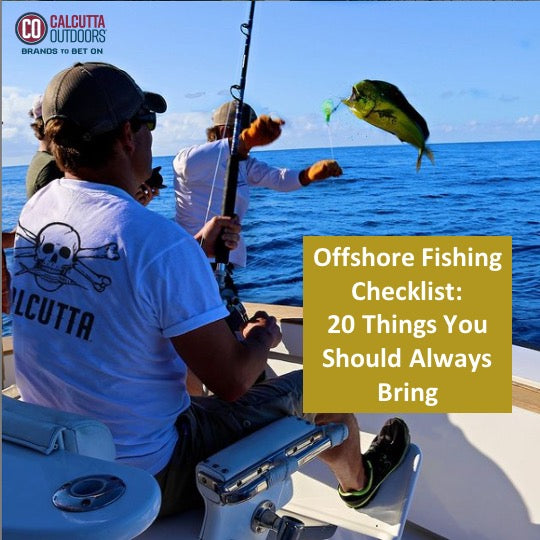
Few things are more exciting than heading offshore to chase marlin, tuna and other saltwater monsters—except maybe hauling in heavy grouper, snapper and bottom fish from the ocean’s depths. There’s never been a better time to book a deep-sea fishing trip. To help you prepare for the adventure, we’ve created this checklist of 20 essential items that you should always carry.
Rods , reels and bait are provided by the charter service, but there’s more than just fishing tackle required for a memorable offshore experience. Comfort is critical and a key ingredient to maintaining the edge needed for those line-stripping runs. Our list of essentials to bring on your first deep-sea fishing trip includes many items overlooked by first timers and a few others that will help you sail through the day like an old salt.
Mandatory Items First
Daily Medicine —Bring an adequate supply of prescription(s) you take daily. It’s unlikely the captain will turn back to shore once underway, unless there’s a life-threatening emergency. Missing one blood-pressure pill may not qualify, so bring enough for the entire trip. Extra is better, just in case weather or mechanical problems delay your return.
Motion Sickness Preventive —Bring seasickness/motion sickness medicine, even if you’re among the lucky few who have never experienced the nausea and discomfort. Those particularly prone to the condition should consult with their physician for a prescription. The inexpensive remedies available at drug stores work for most fishermen, though, and they’re great insurance to have on hand just in case.
Fishing License —More than a few trips have been spoiled when an angler discovers he or she doesn’t have their fishing license. In many cases you can purchase one at the dock, but don’t rely on using your credit card. Bring cash, just in case.
Some states, including Florida, North Carolina and South Carolina, do not require you to have a fishing license if you’re aboard a licensed charter vessel. It’s always best to check with the charter service that you’ve hired, or consult the state’s fish and wildlife website prior to your fishing trip.
Protection from the Sun
Hat —A warming sun at sunrise quickly turns glaring and baking in hot weather. Bring a hat to shade your eyes and protect your head. Bonus points go to those wise enough to choose a wide-brimmed version that shelters the nose, ears and a portion of the neck. Shop Headwear
Neck Gaiter —They stuff into the tiniest bag corners, last for years, weigh next to nothing and quality versions are so breathable you hardly know you’re wearing one. It’s the kind of added protection from the blistering sun veteran offshore fishermen rely on. For those times the water’s reflection is burning into those places the hat promised to shade, simply pull it up to cover your ears, chin and nose when needed. Shop Neck Gaiters Sunscreen —Sunburns hurt and needlessly drain energy, which makes sunscreen/sunblock a key item. Sun exposure while on the water can nearly double, so a liberal application before or as you leave the dock is wise. Repeat the procedure throughout the day. Bring plenty because someone always forgets theirs.
Sunglasses —Lengthy exposure to the sun is fatiguing and can even damage the eyes with enough unprotected exposure. A quality pair of sunglasses remedies the problem and lets you see through glare and into the action below that can be undetectable otherwise. Polarized lenses perform best at the task, but any sunglasses you choose need to be comfortable enough for all-day wear. Shop Sunglasses
Lip Balm —Sun, wind and salt spray dry everything, which makes lip balm another key ingredient for comfort. Get one with a minimum 15 SPF rating for added protection.
Long-Sleeve Shirt —Lightweight and breathable is best, but make sure it’s long sleeved. Today’s high- performance fishing shirts have UPF protection built right into the fabric. Dress in layers on cold mornings because you can always peel some off to maintain comfort as the temperature rises. Shop Sun Protection Shirts
Fishing Accessories
Hand Towel —You’re on the water, things get wet and you’re probably going to sweat during and after that first big hookup. The first mate’s priorities don’t always include handing them out, so bring a hand towel. Shop Bait Towels
Wet Wipes and Hand Sanitizer —When it’s time to enjoy a snack or lunch, you’ll want clean hands. While mates on private charter boats typically do much of the dirty work, you’ll find yourself handling both bait and fish on a deep-sea party boat.
Gloves —Fishing gloves are wise for a variety of reasons, even if the charter’s staff handles the catch on board. They won’t be carrying it to your vehicle or transferring it into your cooler. Gloves also come in handy any time extra protection is needed.
Rain Gear and Footwear
Rain Jacket —You can never be too prepared. Today’s high-tech, lightweight rain jackets take up so little space. You’ll never even know it’s there—until, that is, an unexpected squall rolls in or it’s pouring when you get back to the dock.
Non-Skid Footwear with Closed Toes —Sandals aren’t appropriate when you’re going to be boating toothy fish and baiting sharp hooks. Wet decks and rocking boats make soles that maintain their grip the best way to remain upright during your trip. Save those sandals for grilling out when you get home.
Additional Gear
Cooler —You need something to bring your catch home, so pack a cooler and leave it in your vehicle. Stuff it with ice in the morning, and the cooler will be chilled enough to get that limit of fish to the fridge fresh and unspoiled. Shop Coolers
Drinking Bottle —It won’t take long for the salt air and the fishing action to make you thirsty. Some charter boats provide drinks and snacks, but many require you to bring your own. Regardless, it’s always a good idea to bring along a water bottle or tumbler with a spill-resistant lid filled with water or your beverage of choice. Shop Drinkware
Fish Bag —It can be a long walk back to your vehicle if you’re hauling a heavy load of fish. An insulated fish cooler bag helps you easily shoulder the load while keeping your catch cold and fresh. Have a gunny sack at home? You can wet it down and you’re ready to carry your fish off the boat in fewer trips. Shop Fish Cooler Kill Bags
Cell Phone with Camera —Don’t let that once-in-a-lifetime trip become a faded memory. Bring a camera or carry a cell phone that produces quality images. Saltwater and electronics don’t play together well, so stow them in a sealed plastic bag . Turn on the flash when you do take it out for a photo to capture more lifelike colors and reduce shadows under your hat. You’ll be ready to post that catch-of-the-day photo on Facebook and Instagram as soon as you arrive back at the dock.
Cash —Cash on hand ensures you can tip the crew, get your license and pay for fish cleaning without walking the dock in search of an ATM.
Waterproof Bag —Things often get wet on an offshore fishing boat. It’s always a good idea to store your electronics, wallet, and other important items in a dry bag . While a zip-lock bag will suffice, waterproof dry bags with roll-top closures and welded, waterproof seams are the best choice. They’re durable, perfect for deep-sea fishing trips, and often feature a shoulder strap for carrying. Shop Dry Bags
Check with Your Fishing Charter —Charter services routinely provide rules and recommended gear to bring onboard. Following them improves your experience, ensures safety and often addresses conditions specific to the exact area you will be fishing. Check the charter boat’s website or contact them before your trip to make sure you have everything you need.
Visit a Local Fishing Tackle Store —Before you set foot on a charter boat, stop by a local bait and tackle store—or two. The tackle shop will likely stock many of the items on this list. And when it comes to anything related to fishing, tackle retailers are the experts. They will be happy to share their knowledge and provide up-to-the-minute fishing and weather reports.
Reading next
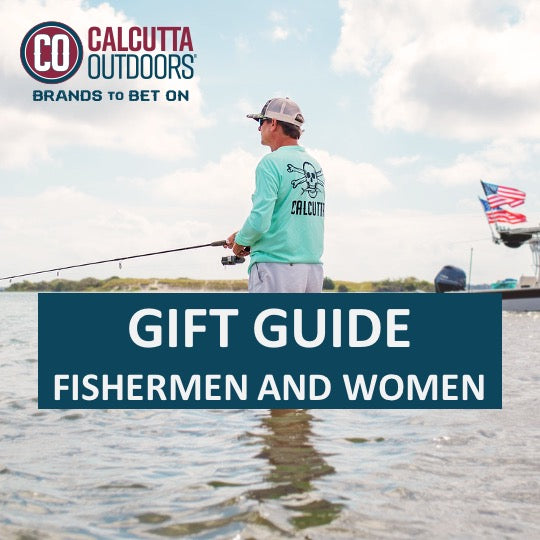
The Best Gifts for People Who Love Fishing
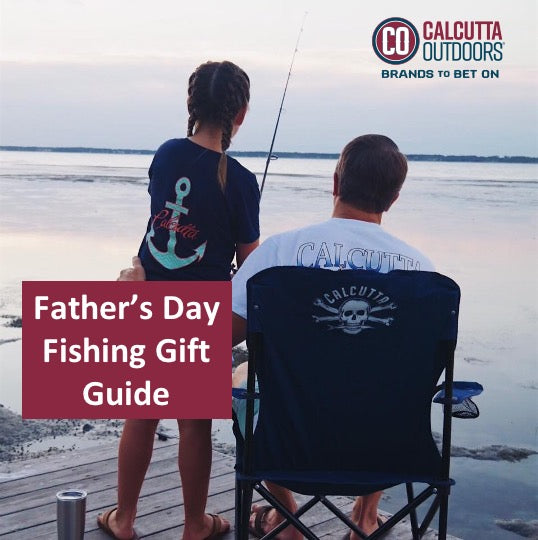
Top Fishing Gifts for Father’s Day 2021
Book Your Next Florida Fishing Charter Adventure Today - 321-652-5903

What to Bring Charter Fishing: The Ultimate Checklist
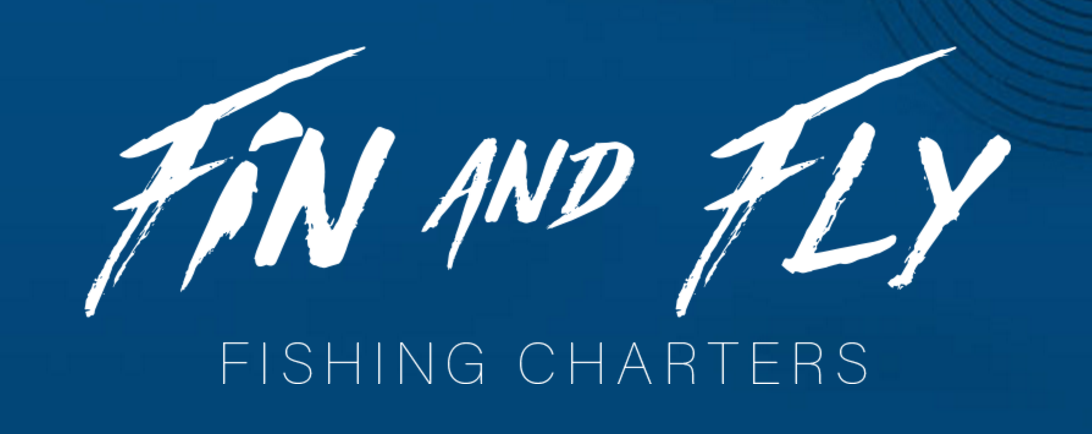
June 21, 2018
You’ve been traveling all day, but you’ve finally made it. You’re in beautiful, sunny Florida and it’s vacation time! Your days here are action-packed, but the one thing you’re looking forward to most is heading out into the open ocean off Cape Canaveral with a professional, experienced deep sea fishing charter. There’s only one problem. You have no idea what to pack!
Don’t panic! Whether you’re experienced or need some deep sea fishing tips for beginners, here’s Fin and Fly’s ultimate deep sea fishing guide to what you should bring along.
Clothing: What to Wear Deep Sea Fishing
When heading out onto Florida’s beautiful Space Coast, the most important thing to remember is that the weather may change. The Sunshine State lives up to its name, but it pays to be prepared! You want to make sure you’ll be comfortable when hauling in your catch.
- Rain gear or windbreaker. These are essential for protecting you from anything from downpours to sea spray! Both will keep you warm if you find yourself a little chilly in the early morning.
- Light clothing. Shorts, a t-shirt, or a light long sleeve shirt will keep you cool under the Florida sun.
- Hat. This will help keep your head cool and the sun out of your eyes.
- Polarized sunglasses. These are a must! Polarized sunglasses protect your eyes from the glare off the water. All the better to see your catch with!
Sunscreen: Fishing Sunblock
The strength of the sun should never be underestimated, even on cloudy days! You don’t want a sunburn ruining your day. You’ll be wincing every time you cast! The reflection of the sun off the ocean is often nice to look at, but not so nice on your skin.
- Check the SPF! Typically, SPF 50 and above are the sunscreens that are going to give you the highest possible protection from the sun. This is not the time to break out the tanning oil!
- Chapstick or lip balm. Chapstick with SPF or sun protection will be a huge help and will stop your lips from getting burnt or chapped out on the water.
- Zinc. Yeah, your nose will look a little funny, but lifeguards swear by it!
First Aid: Deep Sea Fishing Preparation
The phrase “don’t rock the boat” doesn’t apply to the ocean waves. Whether you find your stomach easily upset by the motion of the ocean or find yourself with an unexpected cut, you can’t go wrong with packing a couple extras to make sure your trip is safe and comfortable!
- Motion sickness medication. If you’re likely to suffer from seasickness, this is a must. Take it an hour or so before your trip to make sure you’re not adding a little extra bait to the water.
- Extra band-aids. Larger first aid kits are provided on the boat, but it never hurts to be prepared.
- Hand sanitizer. You packed a great sandwich and you’re ready to dig in. Just make sure you get the fish slime off your hands first.
Food and Drink: What to Eat Deep Sea Fishing
Everyone’s gotta eat, and in the hot sun, you want to make sure you’re hydrated. Here are some fishing trip snacks and tips that are perfect for your day on the water.
- Thermos or large water bottle. A thermos or water bottle with a guarantee that your beverage will stay cool for long periods of time is perfect for a fishing trip.
- Sandwiches. Pack your favorite! But remember, hand sanitizer is your friend.
- Beverages. A cold, hydrating beverage that is perfect for a day at sea.
- Other snacks. Chips, granola, jerky, you name it.
What Fin and Fly Provides: Cape Canaveral, Cocoa Beach, and Orlando Fishing Charters
You’re all packed! Here’s a few things we made sure you don’t have to worry about.
- Fishing license. We’ve got you covered. You don’t need to obtain a fishing license to come catch huge fish with us!
- Bait. We have the best bait and lures around to make sure you catch what you’re looking for.
- Camera. We’ll make sure to get a picture of you and your catch that you can show off to all your friends. If you want to bring your own camera to take some pictures with, that’s fine too!
- Coolers and ice. For keeping your favorite beverages nice and cold.
Use this fishing trip checklist when checking out our charters out of Cocoa Beach, Cape Canaveral, and Orlando, Florida! Available to book online or by phone today!
Plan a Deep Sea Fishing Trip in 2023 (With Packing List)
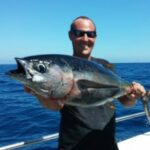
Geoff Stadnyk in Fishing On The Water on March 13, 2024 March 13, 2024

Your first deep sea fishing trip can be the trip of a lifetime (assuming you don’t get seasick ). Do you dream of pulling in a shark? Would you settle for a sea trout? Whatever you’re targeting, it’s time to start planning.
Travel for deep sea fishing isn’t – and shouldn’t be – a spur of the moment event ( unlike inshore fishing ). For your safety, and for the best catch, you’ll need to plan ahead. Here’s how to plan a deep sea fishing trip you’ll remember for years to come.
Choose Your Destination
When you’re planning a deep sea fishing trip, choosing your destination is almost as exciting as getting out on the water. Think about it: with over 95,000 miles of American coastline, to say you have plenty of options is an understatement. Thinking about an international trip? The world is just a charter away.
Don’t let all that saltwater overwhelm you. Choosing where you’ll wet your line is easy when you consider what you’d like to accomplish. Ask yourself a few questions:
- Will I stay within the states or travel globally?
- What is my budget?
- What fish am I targeting?
- How long will I be at my destination?
- Will I hire a group charter or a private one?
Once you’ve answered those basic questions, you’ll have a better idea of where to get started. Let’s assume you’re planning a trip within the United States. You wouldn’t mind staying a week or so, and you certainly wouldn’t mind pulling a few mahi-mahi into your boat.
Now you’re starting to narrow it down! You already know that, say, Maine isn’t going to be your destination this time. Do a little research now, and talk to experienced fishermen either in person or on online forums. Don’t be afraid to ask questions! Fishermen love little more than to talk about fishing!
Once you’ve got a general idea of the general geographical area and the body of water you’re going to visit, it’s time to plan a bit more in depth.
Choose Your Charter
If you’re an experienced shore fisherman, you may be tempted to charter your own boat and head out with a few friends. We strongly advise against that.
Deep sea fishing is a completely different animal to inshore fishing like fishing from a pier or surf fishing from the beach , and you’ll want an experienced guide. Not only will your guide help ensure your safety throughout your trip, they’ll also be experienced in those specific waters – that means prime fishing for you.
With that in mind, there are three general types of charters you can hire. Let’s look at your options.
Private Charter
The first is a private charter. A private charter is a boat that’s hired solely for you and your friends. The group will usually pay one set fee, and you’ll generally be given to option to rent onboard equipment or bring your own.
Group Charter
The second is a group charter. You and your group can still fish together, but you’ll be sharing the boat with other small groups with similar interests. There are typically from six to 15 or so people in a group charter, and your boat will be around the 20-foot ballpark. Group charters are great if you want a slightly more cost-effective trip and don’t mind a few friendly strangers.
Offshore charters can be either private or group-based. Private charters offer exclusivity, allowing individuals or groups to book the entire boat for themselves and customize the trip. Group charters, on the other hand, enable individuals or small groups to book spots on a shared boat, offering a more economical option. Private charters provide privacy and tailored experiences, while group charters offer affordability and the opportunity to meet new people.
Both private and group charters have their own advantages and appeal to different types of customers, so it’s essential to inquire with the charter company about their offerings and choose the option that best suits your needs. You might want to consider an offshore fishing charter, where they provide all the gear . That way, you can focus on the experience without worrying about equipment.
Offshore fishing charters are popular for their access to deeper waters and larger fish species. Whether opting for a private or group charter, these trips offer memorable experiences for anglers of all levels. Be sure to communicate your preferences, such as targeting specific fish species or focusing on certain techniques, to ensure the charter meets your expectations. With the right choice, an offshore fishing charter can provide an exciting adventure on the open seas.
Your third option is to charter a party boat. Party boats are a fantastic option if you’re just testing the waters of deep sea fishing, so to speak, and want an affordable option. You’ll be on board with a larger group of people – there’s a minimum head count required for most – so if you’re not into the social aspect of fishing this may not be a good option for you. You also may not learn quite as much on a party boat as on a smaller charter.
While many more serious fishermen might be annoyed if you’re in the area just make sure you’re respectful (and that the captain knows how to properly pass a fishing boat ) and you shouldn’t have any issues.
The charter you choose is solely up to you, your budget and your social preferences. (Don’t forget, it’s customary to tip the captain, so factor that in!) Check out reviews, target species and especially charter licenses before you embark.
Where Will You Stay?
Now that you know the general area you’ll be visiting, it’s time to choose your lodging. The possibilities are going to rely on your charter in many ways, but in others it’s all about what you prefer. When you’re booking your lodging, consider:
Most charters leave early in the morning, especially if you’ve booked an all-day trip.
Hotels and lodges around fishing hot spots book up fast and charge higher rates “in season”
Many fishing hot spots are home to quite a few eclectic fishing cabins and cottages
Even if they don’t fish, your family may want to join you and enjoy local attractions
Do some research online and with your destination’s Travel Bureau. What do the locals recommend? Is the lodging close to your charter, allowing for a quicker commute in the morning? Are there amenities on site or local attractions your family will like? Do you need modern accommodations or is a rustic cabin perfect for you?
As with just about every other step of planning your deep sea fishing trip, the hotel you choose has a lot do with your personal preference! This trip will be exciting and memorable no matter what, but it certainly helps to have a convenient, comfortable place to rest your head at the end of a long day.
Pack Your Bags and Go!
Depending on where you’re traveling, what you pack in your suitcase, how many rods you’ll take with you and your tackle box is going to vary. That said, some things are pretty consistent. Don’t forget to pack:
- Your fishing license , unless your charter covers this for you
- Sunblock and a protective fishing hat
- Fishing sunglasses
- Your camera
- Clothes you can layer (think cool mornings and hot afternoon sun)
- Non-skid shoes or fishing shoes
- Tackle recommended for your target, unless this is onboard.
- Cash for tipping
- A cooler to bring your catch home
It is also helpful for you to know the causes and remedies if ever you or someone with you gets dizzy when fishing .
When you book your charter, ask if there are any considerations you may not have thought of. For example, depending on what kind of fishing you’re g oing to be doing, many deep sea fishermen will recommend an electric fishing reel to help with the big boys. Even something as simple as being unprepared for a mid-day Florida rain can turn a great trip uncomfortable very quickly. Check out our helpful guide for what to wear while fishing to get some ideas of what to pack.
Pack for safety and comfort, and don’t worry about the rest. It won’t ruin your trip to forget a toothbrush, so there’s no sense stressing. Remember – your first deep sea fishing trip is the trip of a lifetime. Plan carefully, then relax and just enjoy the experience!
Geoff started fishing as a child in the gorgeous lakes of Mammoth, while on family vacations. His fishing experience includes the use of fly rod and reel. Guided trips along the Madison and Gallatin rivers in Montana, the Frying Pan and Animus in Colorado, and the Deschutes river in Oregon have all paid off and helped make Geoff the angler and writer that he is today.
As an Amazon Associate, Fishermen's Angle earns from qualifying purchases. We get commissions for purchases made through links in this post.
We promise you, we won't flood your inbox. Subscribe today and join our fast growing fishermen community. Receive the latest only from the best!

- Book Your Trip
- Half Day Close Offshore
- Kingfish Trip (6-Hours)
- Shark Hunt Trip (6-Hours)
- Deep Sea Trip (8-Hours)
- Red Snapper Deep Sea Trip
- Blue Water Deep Sea Trip
- What To Bring
- Gift Certificates
- Galveston Attractions and Lodging
Blog Categories
- Amberjack (3)
- Black Drum (8)
- Bull Red (7)
- Deep Sea Fishing (26)
- Fall fishing (1)
- fisherman gifts (7)
- Fishing Charter (41)
- Flounder (10)
- Galveston Attractions (9)
- Galveston Fishing Charters (34)
- Red Snapper (10)
- Redfish (9)
- shark fishing (6)
- Sheepshead (8)
- Spring fishing (7)
- texas fishing charter (27)
- Uncategorized (3)
What to Bring On a Deep Sea Fishing Trip
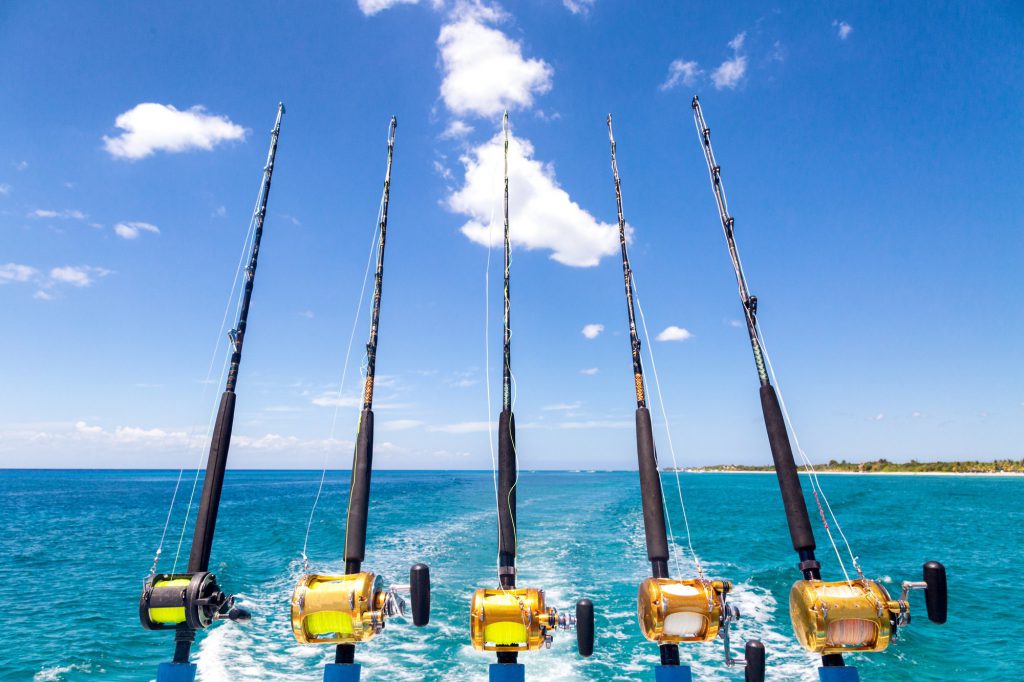
Your first deep sea fishing trip is going to be an amazing adventure. That’s pretty much guaranteed.
The big question remains: what do you need to bring with you?
For the first time angler, deep sea fishing can be something of a mystery. Coming along with that mystery is what you need in your backpack.
Read on and we’ll give you all the information you need when it comes to tackle choices, clothing, and everything else you should make sure is in your bag before setting out and into the blue.
Getting the Tackle Right
Your tackle is one of the most important things to get right from the outset. Where you’re headed out will largely determine the size of rod and reel that you need, but as a general rule, you can stay prepared for a blue water trip by making sure you have the right stuff on hand when you hit the charter boat.
Rods and Reels
The central part of your fishing tackle is always going to be your rod and reel. After all, pretty much everything else can be changed out while you’re on the water.
While most charter companies, like ours , offer rods, reels, and tackle many of you have a favorite rod you may want to bring along.
For deep sea fishing, a medium-heavy, 6′ to 7′ pole is pretty much the standard. A medium pole can be used for lighter fish, it really depends on what your target species consists of.
You’ll want to go with braided line for your reel for the most part. It’s much stronger than the regular monofilament lines. Something in the range of 20lbs-50lbs is ideal for most people, but if you’re going for particularly big game you may need to go higher.
Hooks and Lures
Hooks are another source of concern for many anglers. The truth is that hook sizes aren’t standardized between brands so it can be hard to figure out exactly what you need. Circle hooks in the range of 4/0 to 7/0 are ideal for most people.
If you’re bringing your own lures, then you’ll want to do research on the fish species you’re targeting. Each species has their own individual tastes and you may be best off using those which are included on the boat by those who know what they’re doing.
The Other Essentials
Apart from the regular stuff, you’ll also want to ensure that you pick up some swivels, weights ranging from 4oz-10oz, and anything else you might think will help you out on the water.
Each angler usually has a preferred setup but if you’re still completely in the dark find a service which offers tackle. You’ll learn quickly, especially if you’re going out on a regular basis.
Dressing Properly
Dressing properly for your trip can make a big difference in how comfortable you are. After all, it can get quite a bit colder on the ocean than you’ll be experiencing on land.
In addition to the regular temperature being lower, you’ll also have to deal with the increased wind chill .
Of course, it can also get quite warm on the ocean as well, depending on the weather. This means it’s best to dress in three or four different layers so that you can change your dress at your leisure to remain comfortable.
For most people that will mean at least the following:
- A heavy jacket with a hood
- A lighter jacket underneath
- A base layer or light hoodie
- A t-shirt or other casual undershirt underneath
That will give you four different variations of upper body wear. Others may wish to do the same with their lower body or at least pull on a pair of good pants over shorts.
The important thing is being able to adapt to whatever the weather may bring.
Other Necessities for a Deep Sea Fishing Trip
If you’re on a charter boat, then it’s important to be aware that different boats have their own rules for what you are and aren’t bringing on.
For instance, many will forbid alcohol entirely but our charters will allow you to bring beer as long as it’s not in a glass bottle. No hard liquor, however.
You’ll also want to bring some snacks, something for lunch, and probably a camera of some sort to document your catches.
Some of the other things people have found useful include the following:
- A collapsible ice chest
- SPF 30+ sunscreen
- Polarized sunglasses
- Seasickness medications
Just make sure to double check your bag the night before so that you can rest assured that you have everything you need.
Sunscreen is important no matter what time of year or the weather while on the open water. Between the lack of shadows on the boat’s deck and the fact that the water will be reflecting some of the sunlight, it’s easy to get burned even in weather you wouldn’t normally consider to be a threat.
Prepping Yourself
Deep sea fishing can be an exhausting matter, even for those who are used to it. Some simple suggestions can make your trip go a lot easier.
The biggest one is this : don’t drink heavily the night before setting out. It will increase your chances of getting seasick and a hangover can definitely ruin a day on the water even if everything else goes well.
On top of that, you’re going to want to make sure that you’re in decent physical shape. If you’re planned out a bit further it may be time to spend a little bit of extra time in the gym before your trip.
Start making sure you’re extra well hydrated in the days leading up to your trip as well. Starting to drink more water three days or so beforehand can make your trip a lot smoother.
Lastly, if you’re prone to seasickness, then you’ll want to take your medication about an hour before embarking so that it’s already in full-effect before you arrive in a choppy ocean.
Are You Ready?
If you think that you’re adequately prepared for a deep sea fishing trip, then what’s holding you back? It’s about time to go on the trip that you deserve.
Getting ready isn’t nearly as much fun as hitting the water with the intent of bringing in a brand new fish story.
If you’re thinking about contracting a charter fishing boat to take you out for the time of your life, then we urge you to book with us and set up a brand new adventure.
Two-piece rods, because of their heavy weights, tend to be very clumsy to use, especially if you’re just starting out. A one-piece fishing rod is a lot lighter and can allow even beginners to use them without any problems.
It really helped when you talked about deep-sea fishing and what clothes are better for it. My brother and I want to go on a fishing trip to celebrate his birthday next month. We’d like to know what we should prepare for our fishing adventure, so we’ll gladly read your tips carefully. We appreciate your advice on how to be comfortable while spending the day fishing.
The article has really peaks my interest. I am going to like your site and preserve checking for brand spanking new information from feed RSS :-).
After looking into a handful of the blog posts on your website, I truly like your way of blogging. I saved it to my bookmark webpage list and will be checking back soon. Please visit my website as well and tell me how you feel.
Comments are closed.
Winter is here! Check out the winter wonderlands at these 5 amazing winter destinations in Montana
- Travel Tips
What To Bring On A Deep Sea Fishing Trip
Published: December 6, 2023
Modified: December 28, 2023
by Danella Sheikh
- Tech & Gear
Introduction
Embarking on a deep-sea fishing trip is an exciting adventure that allows you to explore the vastness of the ocean and test your fishing skills against powerful game fish. Whether you are a seasoned angler or trying deep-sea fishing for the first time, being prepared with the right gear and essentials is crucial for a successful and enjoyable trip.
In this article, we will discuss the essential items to bring on a deep-sea fishing trip. From fishing gear to safety equipment, personal items to food and drinks, we’ll cover everything you need to ensure a fantastic fishing experience. So, let’s dive in and get ready for an unforgettable deep-sea fishing adventure!
Before we dive into the details, it’s important to note that the specific items you need may vary depending on the destination, duration of the trip, and the type of fishing you plan to do. Always research and consult with the fishing charter or experienced anglers to gather specific information about what to bring for your particular trip.
Now, let’s start with the essential fishing gear you should pack for your deep-sea fishing expedition.
Essential Fishing Gear
When it comes to deep-sea fishing, having the right fishing gear is paramount. Here are some essential items to bring with you:
- Fishing Rods and Reels: Choose sturdy, saltwater-resistant rods and reels that can handle the weight and power of big game fish. Be sure to pack a variety of rod sizes to accommodate different fishing techniques and target species.
- Fishing Line: Use high-quality monofilament or braided fishing line with a suitable pound test. The line should be strong enough to withstand the pressure of fighting large fish.
- Tackle Box: Fill your tackle box with a selection of hooks, sinkers, swivels, and lures. Include a range of sizes and styles to match the fishing conditions and the preferences of various fish species.
- Extra Fishing Line and Leader Materials: It’s always a good idea to carry spare fishing line and leader materials in case of line breakage or damage during your fishing trip.
- Fishing Tools: Bring a set of essential fishing tools, such as pliers, line cutters, hook removers, and a fish scaler. These tools will come in handy for baiting hooks, removing fish from the line, and handling catch.
- Bait and Lures: Pack a variety of live bait, such as squid, shrimp, or sardines, as well as artificial lures that mimic the prey of the target fish species.
- Fishing Accessories: Don’t forget to include other fishing accessories like a fishing net, rod holders, and a gaff for landing bigger fish.
Remember to check the local fishing regulations and guidelines to ensure you are using permitted bait, lures, and fishing methods in the area you plan to fish. Now that you have your fishing gear packed, let’s move on to the personal items you’ll need for your deep-sea fishing trip.
Personal Items
While the focus of a deep-sea fishing trip is on fishing, it’s important not to overlook personal items that will enhance your comfort and overall experience. Here are some essential personal items to bring:
- Sun Protection: The sun’s rays can be intense out at sea, so pack sunscreen with a high SPF, a wide-brimmed hat, sunglasses with UV protection, and protective clothing to shield your skin from sunburn.
- Seasickness Remedies: If you are prone to motion sickness, bring seasickness remedies such as over-the-counter medications or natural remedies like ginger candies or wristbands.
- Medications: If you take any prescription medications, make sure to bring enough supply for the duration of your fishing trip. It’s also a good idea to have a basic first-aid kit with bandages, antiseptic ointment, and pain relievers.
- Personal Hygiene Products: Pack essentials like toothbrush, toothpaste, soap, and any other personal hygiene products you may need during the trip.
- Extra Clothing: It’s wise to bring extra clothing to account for changing weather conditions and any unexpected situations. Quick-drying and moisture-wicking fabrics are recommended, as they provide comfort even when wet.
- Towels and Wet Bags: Carry a couple of towels for drying off or wiping down equipment. Additionally, a waterproof bag or a dry bag will come in handy for storing wet or dirty clothing to keep the rest of your gear dry.
- Camera: Capture the memorable moments of your deep-sea fishing trip with a waterproof camera or a protective case for your smartphone to capture photos and videos.
These personal items will ensure your comfort, safety, and convenience during your adventure at sea. Now let’s move on to the safety equipment you should have on board.
Safety Equipment
When venturing into the deep sea, safety should be a top priority. Here are some essential safety equipment items to bring on your fishing trip:
- Life Jackets or Personal Flotation Devices (PFDs): Make sure each person on board has access to a properly fitting life jacket or PFD. Safety regulations may require that they are worn at all times.
- Emergency Communication Devices: Carry a fully charged cell phone or a marine VHF radio to communicate with others in case of an emergency. Ensure you have a way to keep these devices dry and protected.
- Personal Locator Beacon (PLB): A PLB is a small device that, when activated, sends out a distress signal to alert search and rescue authorities of your location in case of a life-threatening situation.
- Emergency Flares: In the event of an emergency, flares can be used to signal for help. Familiarize yourself with how to use them correctly and ensure they are within their expiration date.
- Fire Extinguisher: Keep a portable fire extinguisher on board to handle any potential fire hazards that may arise.
- Anchor and Rope: Having a reliable anchor and rope system is essential for maintaining the position of your vessel during fishing and in case of engine failure.
- Navigation Tools: Carry a compass, GPS device, or marine charts to aid in navigation and ensure you know your precise location at all times.
Additionally, it’s advisable to familiarize yourself with basic boating and safety protocols, such as identifying emergency exits, life raft locations, and the proper use of safety equipment. Remember, safety should never be compromised during a deep-sea fishing trip.
Now that we’ve covered safety equipment, let’s move on to discussing the clothing and accessories you should bring for your fishing adventure.
Clothing and Accessories
When preparing for a deep-sea fishing trip, choosing the right clothing and accessories is essential for your comfort and protection. Here are some items to consider:
- Appropriate Clothing: Wear lightweight, breathable clothing that provides sun protection. Opt for long-sleeved shirts, long pants, and a wide-brimmed hat to shield yourself from the sun. Avoid wearing clothes with loose ends that can get caught in equipment.
- Layered Clothing: Weather conditions can change quickly at sea, so having multiple layers is a good idea. Bring a light jacket or fleece in case of cooler temperatures or inclement weather.
- Non-Slip Footwear: Choose comfortable, closed-toe shoes with non-slip soles. These will provide stability on the wet and often slippery surfaces of the boat.
- Gloves: Consider bringing a pair of gloves to protect your hands when handling fish, fish lines, or sharp fishing equipment.
- Sun Protection Accessories: Don’t forget to pack sunscreen, sunglasses with UV protection, and a wide-brimmed hat to shield yourself from the sun’s harmful rays.
- Rain Gear: Sudden rain showers are not uncommon at sea, so be prepared with a waterproof jacket or poncho to keep yourself dry.
- Sea Sickness Bands or Medication: If you are prone to motion sickness, sea sickness bands or over-the-counter medications can help alleviate symptoms and ensure your comfort throughout the trip.
Remember, dressing appropriately will not only keep you comfortable but also protect you from the elements. Now, let’s discuss the food and drinks you should bring to stay nourished during your deep-sea fishing adventure.
Food and Drinks
Deep-sea fishing can be a physically demanding activity, so it’s important to stay nourished and hydrated throughout the trip. Here are some tips for packing food and drinks:
- Water: Carry an ample supply of bottled water or refillable water bottles. Staying hydrated is crucial, especially under the sun and physical exertion.
- Snacks: Bring a variety of snacks such as granola bars, trail mix, or sandwiches to keep your energy levels up during the day. Opt for non-perishable items that can withstand the heat and won’t spoil.
- Meals: Pack meals that are easy to eat and don’t require much preparation. Sandwiches, wraps, or pre-packaged meals can be convenient options. Don’t forget to bring any necessary utensils, napkins, and food storage containers.
- Fruits and Vegetables: Include fresh fruits and vegetables in your food provisions. They provide essential nutrients and offer a refreshing break from heavier snacks.
- Caffeine and/or Energy Drinks: If you need an extra boost of energy during a long fishing trip, consider packing caffeinated beverages or energy drinks.
- Ice: If you plan to keep your catch or any perishable food items cold, bring enough ice in a cooler to maintain their freshness.
It’s important to note that some fishing charters may provide food and drinks as part of the trip, so confirm this in advance to avoid overpacking. Also, be mindful of the boat’s policies on bringing food to ensure compliance.
Now that we’ve covered food and drinks, let’s move on to discussing the navigation and communication devices you should have on hand during your deep-sea fishing trip.
Navigation and Communication Devices
Having the right navigation and communication devices on board is crucial for a safe and successful deep-sea fishing trip. Here are some essential items to consider:
- GPS Device: A Global Positioning System (GPS) device is a valuable tool for ensuring accurate navigation and helping you find your way in open waters. Make sure it is fully charged and has updated marine charts.
- Marine VHF Radio: A marine VHF radio is essential for communication with other vessels, as well as emergency coastal or offshore services. Familiarize yourself with its operation and keep it accessible and dry at all times.
- Compass: A compass is a reliable and simple navigation tool, especially when used in conjunction with nautical charts. It can help you maintain your heading and navigate in the event of electronic equipment failure.
- Mobile Phone: While not a dedicated marine communication device, a fully charged mobile phone can still be useful in times of emergency or when close to shore. Keep it in a waterproof case or bag to protect it from the elements.
- Backup Batteries and Chargers: Ensure you have spare batteries and chargers for all your electronic devices. Having power backups can be vital, especially during extended trips.
Having these navigation and communication devices on board will provide you with the necessary tools to navigate safely and stay connected in case of any emergencies or communication needs.
Now that we’ve covered the navigation and communication devices, let’s move on to discussing the fishing licenses and permits you’ll need for your deep-sea fishing trip.
Fishing Licenses and Permits
Before casting your line in the deep-sea, it’s essential to ensure that you have the necessary fishing licenses and permits. Fishing regulations vary by location, so here are some general considerations:
- Research Fishing Regulations: Familiarize yourself with the fishing regulations and licensing requirements of the area you plan to fish. Regulations may differ for recreational fishing, commercial fishing, or specific species.
- Obtain a Fishing License: Ensure that you have a valid fishing license for the specific location and type of fishing you intend to do. Many areas offer daily, weekly, or annual fishing licenses, so choose the option that best suits your needs.
- Species-Specific Permits: Some areas require additional permits for certain fish species, such as grouper, snapper, or tuna. Check if any specific permits or tags are necessary when targeting certain fish.
- Electronic Licenses: In many places, fishing licenses can now be obtained online or through mobile apps. Research the options available and carry a digital or printed copy of your license with you.
- Consider Charter Regulations: If you plan to fish on a charter boat, confirm with the captain or charter company if they provide the necessary licenses and permits. It’s important to be aware of any additional regulations or fees associated with the charter.
Respecting fishing regulations not only ensures compliance with local laws but also helps maintain the sustainability of the marine ecosystem. Make sure to carry your fishing license and any required permits with you during your deep-sea fishing trip.
Now that we’ve covered fishing licenses and permits, let’s move on to discussing the importance of having a well-packed first aid kit on board.
First Aid Kit
When heading out on a deep-sea fishing trip, it’s crucial to have a well-stocked first aid kit on board. Accidents and injuries can happen, and being prepared can make all the difference. Here are some essential items to include in your first aid kit:
- Bandages and Dressings: Pack a variety of adhesive bandages, sterile gauze pads, and adhesive tape to dress and protect wounds.
- Antiseptic Solutions: Include antiseptic solutions such as hydrogen peroxide or antiseptic wipes to clean cuts or wounds.
- Pain Relievers: Carry over-the-counter pain relievers like acetaminophen or ibuprofen to provide relief from minor aches and pain.
- Medications: If you have any prescribed medications, be sure to include them in your first aid kit. It’s also a good idea to carry basic over-the-counter medications for common ailments like allergies or motion sickness.
- Scissors and Tweezers: These tools can come in handy for cutting bandages or removing small splinters or foreign objects.
- Protection Gear: Include disposable gloves, a CPR mask or face shield, and a tourniquet, if possible, for effective first aid administration.
- Emergency Contact Information: Have a list of emergency contact numbers, including the coast guard and local emergency services, readily accessible in case of emergencies.
It’s important to regularly check and replenish your first aid kit, ensuring that all items are in good condition and within their expiration dates. Additionally, consider getting first aid training to enhance your knowledge and confidence in responding to potential emergencies.
Now that we’ve discussed the importance of a well-stocked first aid kit, let’s move on to some miscellaneous items that can enhance your deep-sea fishing experience.
Miscellaneous Items
While the essentials are crucial for a successful deep-sea fishing trip, there are also some miscellaneous items that can enhance your overall experience. Here are some additional items to consider packing:
- Fishing Journal or Logbook: Keeping a fishing journal or logbook allows you to record the details of your trip, including the catch, weather conditions, and successful fishing techniques. It can be a valuable resource for future trips and helps you track your progress as an angler.
- Extra Cash: Bring some extra cash for tipping the crew, purchasing items on the boat, or unexpected expenses that may arise during your trip.
- Portable Cooler: If you plan to keep your catch, a portable cooler can help keep it fresh until you return to shore.
- Entertainment: Longer fishing trips may warrant some form of entertainment such as books, magazines, or a deck of cards to help pass the time between bites.
- Trash Bags: Keep the boat clean and respect the environment by packing trash bags to dispose of any garbage or waste accumulated during the trip.
- Extra Fishing Gear: It’s always a good idea to bring spare fishing gear, such as extra fishing lines, hooks, and leaders, in case any equipment gets damaged or lost during the trip.
While these items may seem miscellaneous, they can make a difference in your overall comfort, organization, and enjoyment during a deep-sea fishing trip. Remember to tailor your packing list to your specific needs and the length of your excursion.
Now that we’ve covered the essential items to bring on a deep-sea fishing trip, it’s time to get packed and ready for an incredible adventure on the open waters. Happy fishing!
Preparing for a deep-sea fishing trip requires careful planning and packing of the right items to ensure a successful and enjoyable experience. From essential fishing gear to personal items, safety equipment to clothing and accessories, food and drinks to navigation and communication devices, fishing licenses and permits to a well-stocked first aid kit, each item plays a crucial role in enhancing your trip.
Remember to tailor your packing list to the specific requirements of your destination, type of fishing, and duration of the trip. Research local regulations and guidelines to ensure compliance with fishing licenses and permits. Additionally, prioritize safety by carrying essential safety equipment, such as life jackets, emergency communication devices, and navigation tools.
Don’t forget to prioritize personal comfort by packing appropriate clothing, sun protection, and seasickness remedies. Stay nourished and hydrated with food and drinks that are easy to eat and won’t spoil. Lastly, consider bringing miscellaneous items like a fishing journal, extra cash, and entertainment to enhance your overall experience.
By being well-prepared and organized, you can maximize your chances of having a memorable and successful deep-sea fishing trip. So, gather your gear, pack your essentials, and get ready to cast your line into the depths to reel in the adventure of a lifetime!

- Privacy Overview
- Strictly Necessary Cookies
This website uses cookies so that we can provide you with the best user experience possible. Cookie information is stored in your browser and performs functions such as recognising you when you return to our website and helping our team to understand which sections of the website you find most interesting and useful.
Strictly Necessary Cookie should be enabled at all times so that we can save your preferences for cookie settings.
If you disable this cookie, we will not be able to save your preferences. This means that every time you visit this website you will need to enable or disable cookies again.
- 2024 BOAT BUYERS GUIDE
- MIAMI BOAT SHOW
- Email Newsletters
- Fishing Boat Reviews
- Fly Fishing
- Marine Electronics
- Fishing Tackle
- Fishing Destinations
- The Bahamas Fishing Guide
- Boating Safety

Packing for a Fishing Trip
- By Jim Klug
- Updated: May 19, 2017
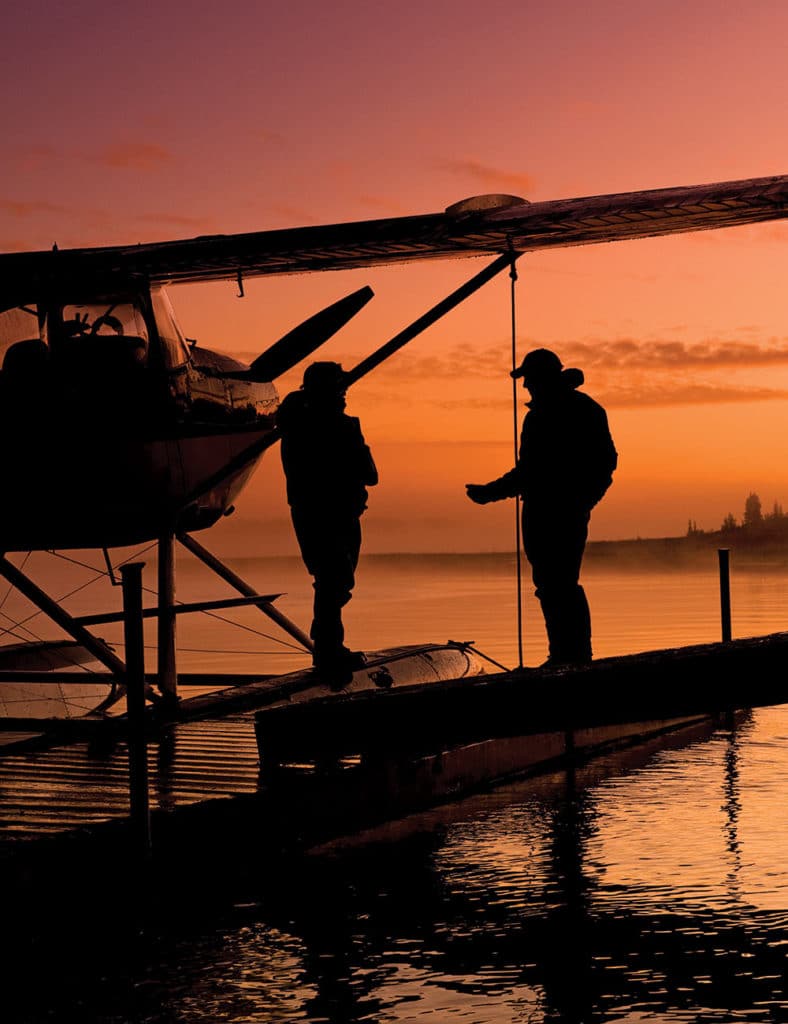
There is no doubt that many anglers have a love-hate relationship with fishing-related travel.
On one hand, you have the adventure and glamour of fishing far-off, exotic waters — opportunities to fish the kind of bucket-list destinations that every angler dreams of visiting. This excitement is frequently offset, however, by the fact that commercial air travel (and the process of checking in, dealing with security, deciphering luggage restrictions and being herded throughout the process like cattle) has made today’s flying much less enjoyable for most travelers. Flying with fishing gear only seems to add to these challenges.
A traveling angler almost always deals with additional hurdles as large amounts of gear, overweight bags, ungainly (and fragile) rod cases, overstuffed bags, and countless numbers of sharp hooks and bizarre tools are all common for destination fishing. When you travel with your equipment, you need to think ahead and pack only what you really need.
As the director of operations for a worldwide, destination angling company, I’ve spent more than 25 years fishing around the world. No matter where I go, I am usually loaded down with rods, reels, camera gear, communication devices and everything else typically associated with fishing and exploring distant waters. Along the way, I’ve managed to pick up several great travel habits and practices, and over the years, I’ve developed a system for packing that always makes my trips easier and more enjoyable.
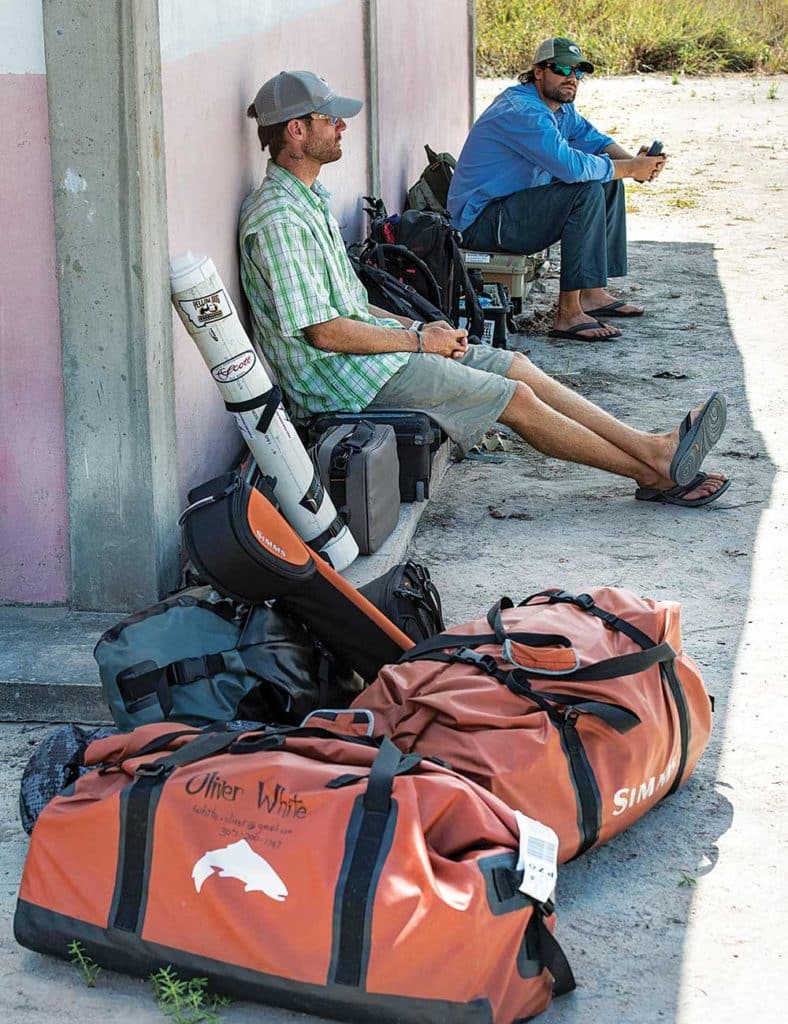
Cut in Half
For whatever reason, it seems to be human nature to pack too much, no matter where you’re headed or what you’re doing. As a part of my pre-trip packing ritual, I always lay out all clothing and equipment, and then try to cut the overall amount in half. I rarely wear all the clothes I pack and have determined that, in most fishing destinations, it’s easy to get by with far fewer clothes than one might expect. Almost every fishing lodge offers laundry service, which means you don’t need to bring as much clothing. So pack smartly for the specific area you’re visiting. Headed to the tropics? Leave jeans and heavy layers behind. Bring lightweight, quick-drying garments instead.
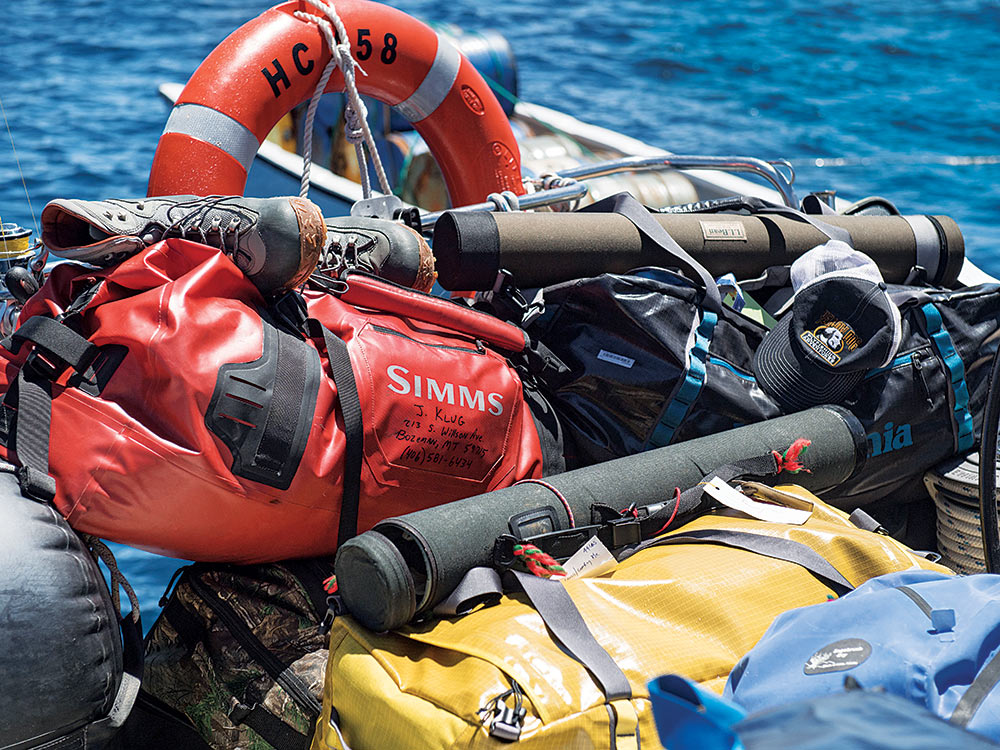
Stuff It Right
Think about where you’re going and pick the kind of bags that are appropriate for your destination. If your travels entail open boat rides or scenarios where bags may get wet (envision your bag sitting on the tarmac in a rainstorm), then go with a heavy-duty, waterproof duffel to keep your clothing and gear dry. If you’re headed to a lodge where everything comes and goes via small planes, leave the hard-sided, wheeled luggage at home and go with something soft-sided and easy for the guides and pilots to pack in tight spaces. Also, remember that when small airplanes are involved, weight is always a factor.
Divide and Conquer
When traveling to remote fishing areas that require multiple flights, skip the giant, single suitcase and consider packing two smaller pieces of checked luggage. Divide your gear between the two bags. That way, if one bag is lost or delayed, you’re still in the game. Even in the age of inflated fees, many airlines allow you to check two bags with no charge on international flights.
Critical Carry-On Items
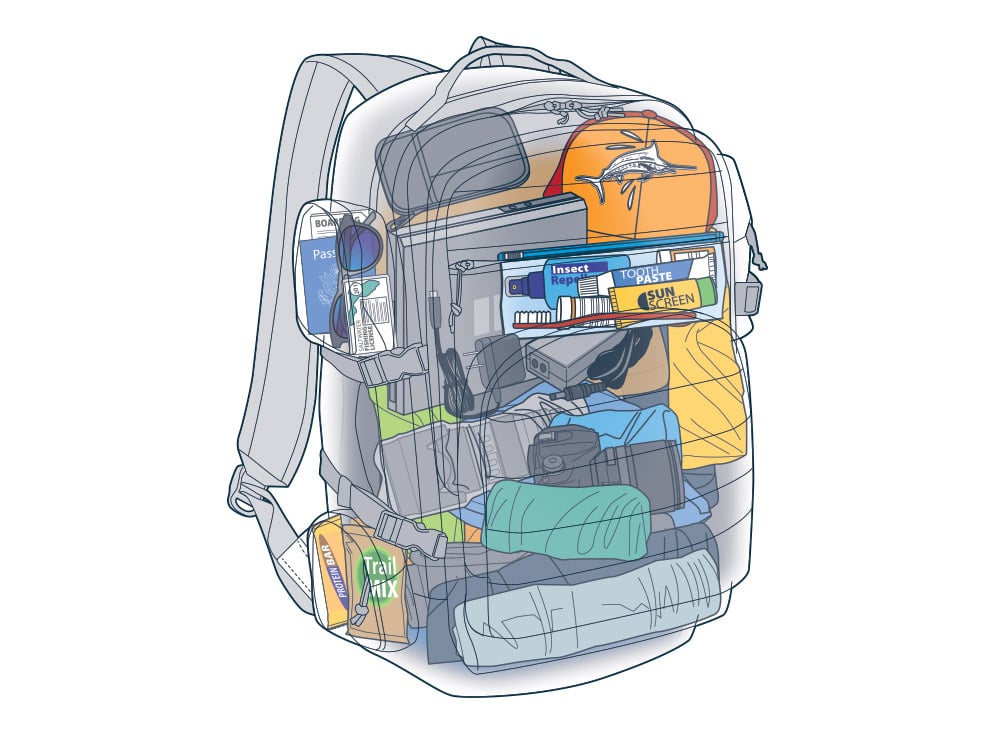
I always pack my most important items in my carry-on backpack or boat bag. This list includes fishing clothes, sunglasses, a hat, snacks, my laptop computer or iPad, camera gear, toothbrush, cash, important medications and essential travel documents. If my checked luggage is delayed or lost, at least I can survive and fish for the first couple of days with the items I’ve carried on.
Check or Carry On Rods and Reels?
This, of course, is a top concern of most traveling anglers. It used to be we always recommended people to actually carry on their rods, reels and other important tackle, and to avoid checking these items at all costs. With enhanced security and new rules and regulations, however, things have changed. Many foreign countries (including Canada, Argentina, United Arab Emirates, Venezuela, Cuba and several others) no longer allow anglers to bring rods, reels or even fly lines onto aircraft. Despite the fact that FAA rules state these items are technically allowed to be carried on, overseas TSA-type entities are too unpredictable and arbitrary when it comes to their policies for bringing these items through security. I once missed a connecting flight in Europe when I had to return to the main terminal to recheck my rod carrier. These days, I always pack all rods, reels and lines in my checked luggage, well-padded, protected and secured with a TSA-approved lock on my bag.
Charge Your Batteries
Whether you’re headed to the wilds of Alaska or a distant location like the Seychelles, fishing a remote destination often means either no power or limited electricity. Things can get difficult when it comes to charging cameras, laptops, iPhones and other electronics. It makes sense to have a portable mini charger when traveling. There’s nothing worse than holding the fish of a lifetime and realizing you’re dealing with a dead camera battery.
When traveling internationally, be sure to bring the right electrical adapters and converters as well. One useful item to always pack is an all-in-one international electrical converter — a small device available in most electronics stores and airport gift shops.
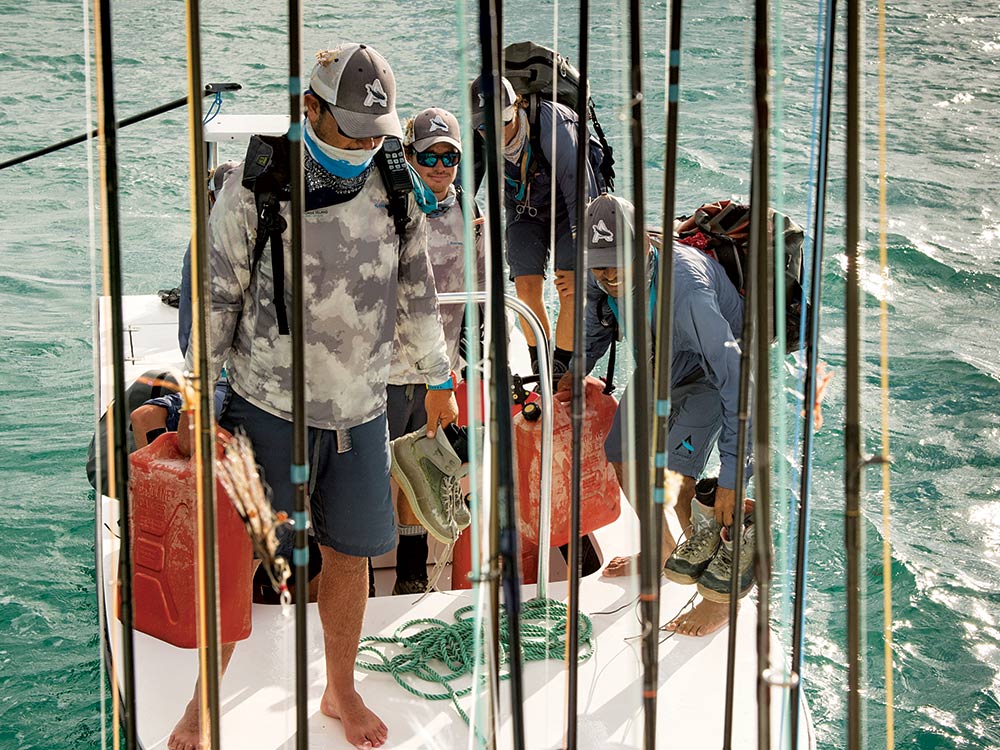
Bring Extra Cash
It’s always a good idea to bring along extra cash when traveling out of the country. Obviously, the farther off the grid you go, the fewer ATMs you’re likely to find. On top of that, remote fishing lodges, hotels and restaurants usually do not take credit cards, and we all know old-school traveler’s checks have largely become a thing of the past.
Whenever I travel to foreign countries, I often end up using more money than I planned, which is why I stash several hundred dollars in backup emergency cash that I can access if needed. Remember, it’s better to have it and not spend it than to need extra cash and struggle to find it. Bring enough small bills for tips and incidentals. Change may be hard to find.
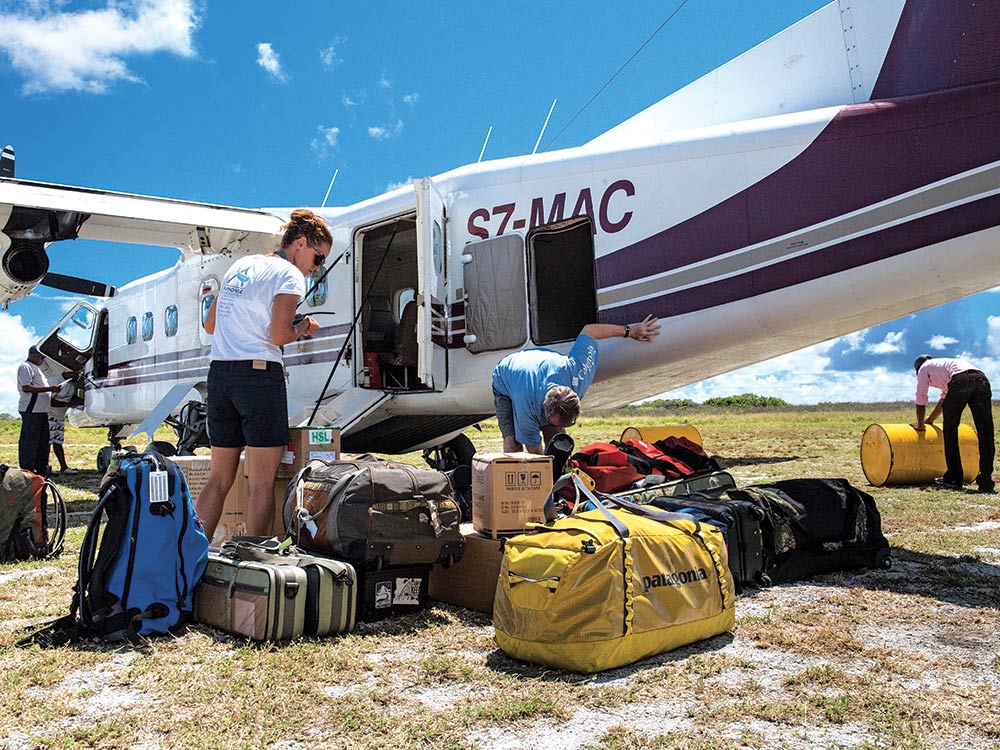
Tag Your Luggage for the Trip
TaMake sure every piece of checked luggage is well-marked and easy to identify. I use a lot of Simms and Patagonia soft-sided duffels made with heavy-duty, waterproof or water-resistant materials. I want my bags to be easily identified, which is why I write out my name and contact information on these bags with a giant Sharpie. A traditional luggage tag works until it is ripped off your luggage or broken. I also include a copy of my flight and travel itinerary inside each checked bag (on the top). More than once this has resulted in my luggage finding me quickly, even when jumping from place to place.
To pack well, plan ahead, and research the areas you’ll be visiting . Bring the right gear packed effectively, and upon arrival, you’ll be able to focus on the fishing and having fun instead of worrying about lost luggage, broken gear or unexpected bag problems.
Fast Facts for Success
What to Take : Make a pile, then cut it in half. How to Pack : Favor smaller bags over one huge one. Think Ahead : Match your luggage to your conveyance, such as boats or small planes.
Quick-and-Easy Travel Tips for Fishing
- Use a packing list. Update and edit your own gear list and adhere to it religiously.
- Pack photocopies of your itinerary, passport and phone numbers in multiple bags.
- If you are headed to the tropics, pack your rain jacket for quick access.
- Reel handles can break. Wrap them in clothes or put them in a padded case.
- Hand-write important contact numbers and bring them with you.
- Weigh checked luggage at home to be sure it’s under the limit and avoid additional fees.
- Wear slip-on shoes for easier clearance through airport security.
- Bring a fleece, even to warm climes. Mornings and evenings are often cool, and airplanes are notorious for being cold.
- Bring cash in small bills for tips and be sure that all bills are in new or mint condition.
- Roll your clothes when packing, never fold or bunch. Use clothes to protect fragile items.
- Rig as much tackle as possible (backing, lines, leaders, etc.) before you leave home. Be ready to fish as soon as you arrive at your destination.
- Take a lot of photos. Great photos are the ultimate souvenirs.
- Travel insurance is worth purchasing for big-ticket trips that are largely nonrefundable.
- Insect repellent goes on every trip, even the ones for which people say you won’t need it!
- Don’t be afraid. The world is not nearly as dangerous as the media makes it out to be. Use common sense and you’ll almost always be OK.
- Remember: If you’re not sure about packing something, you probably don’t need it.
- More: North America , Travel
- More Travel
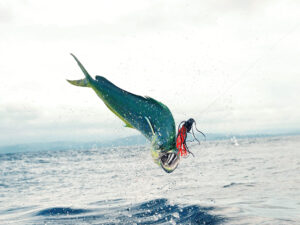
Where to Fish in May
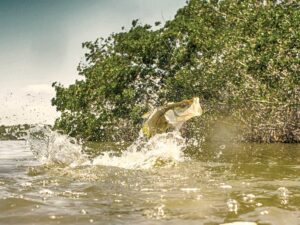
Fun Fishing at the Historic Flamingo Lodge

Targeting Redfish in the Georgia Bight

Unusual Tuna Hotspots
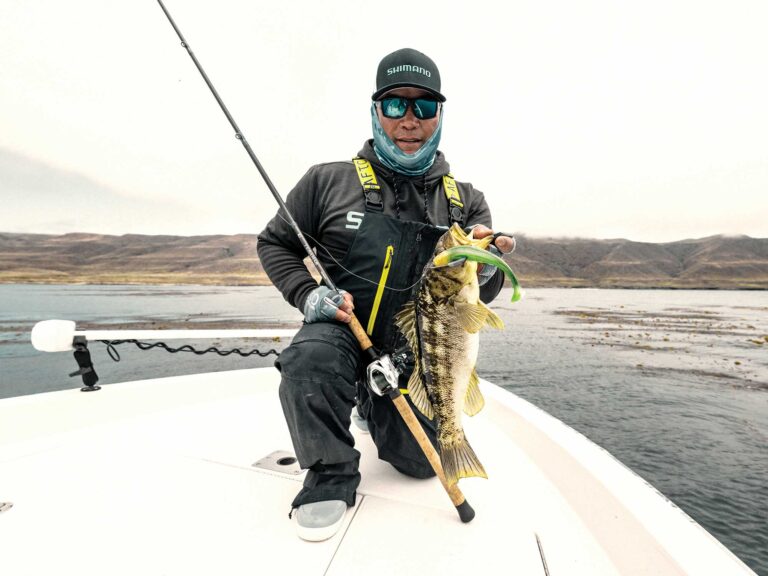
Using Weedless Baits to Catch Calico Bass
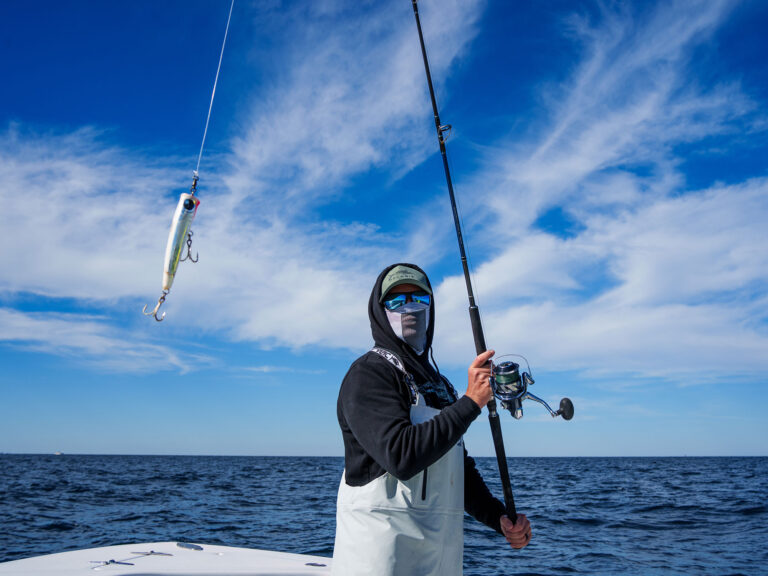
Popping for Tuna
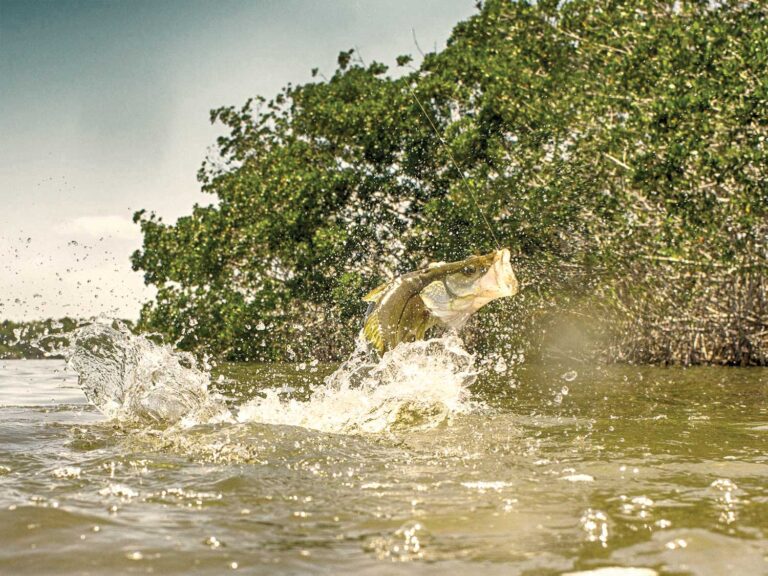
The Mission to Make Custom Boat Gear Convenient, Easy & Fun

- Digital Edition
- Customer Service
- Privacy Policy
- Cruising World
- Sailing World
- Salt Water Sportsman
- Sport Fishing
- Wakeboarding
Fishing Trip Packing List
We started Captain Experiences to make it easy to book fishing and hunting guides around the world. With over 1,500 Damn Good Guides, our platform makes finding and booking a trip seamless. Head here to check out our trips.
Going Fishing
While most of our guides here at Captain Experiences will provide everything you need for a great day on the water, you might be curious to know what they’re bringing so you can be ready for your next solo adventure.
When you’re going fishing, one of the most important things you can do is to get prepared for a successful trip. Below is all the information you’ll need to get out on the water and have a Damn Good Trip.
Fishing Must Haves
It’s hard to have a bad time fishing, but it’s hard to fish at all without having the right angling supplies.
Our guide Chris says it best “We send a very detailed list to our adventurers. I can always tell who reads these and who doesn’t.”
To have the best experience, it’s important to be prepared, here is a list of everything you’ll need.
The Best Fishing Gear
To get started, you’ll need some basic fishing gear. Now of course this list will be different depending on whether you’re doing some fly fishing in the creek, or targeting wahoo in blue water.
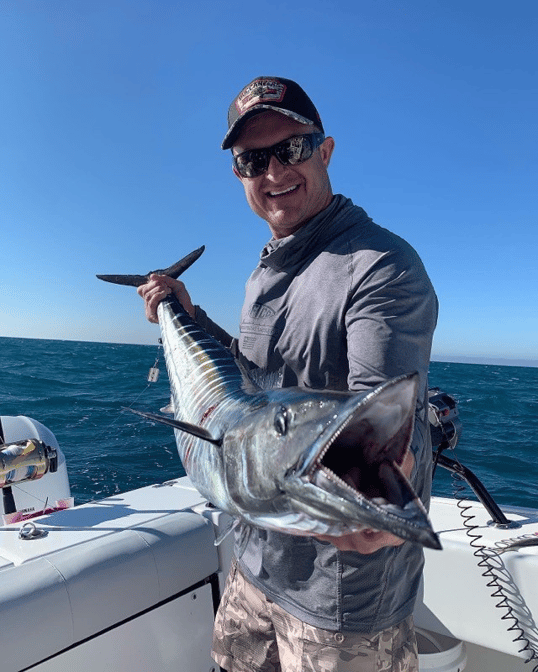
No matter what type of fishing you’re doing, or which species you’re hoping to land, this should give you a good idea on how to get started with some of the best fishing gear, along with some advice from our captains.
1. Fishing license and fishing regulations information: First thing’s first, need to make sure you’re legal. Be sure to check out your local regulations and purchase your fishing license. Nothing quite ends a fun fishing day like a bad experience with a game warden. If you don’t know where to start, we have you covered on access to licensing and regulation information by state here .
2. Rods and Reels: Unless you’re going old school and trying to catch some fish by hand, spear, or bow, you’ll need some rods and reels. Now what exactly you’ll need will vary on whether you’re fly fishing, freshwater fishing, or saltwater fishing. If you’re in the salt for example, you’ll have to decide the level of power and action you’ll need to handle, whether you want a spinning rod or baitcaster, if you’ll need a trolling rig, or a jigging rod and reel. Different species, skill levels, and spots will require different rods and reels.
If that all sounds like gibberish, our captains and guides have you covered. “The most important gear we bring is the actual rod and reels rigged up with the best tackle for the booked trip. The captain knowing what to rig up for each specific trip type makes a huge difference in the success for the day” - Captain Mike Short
3. Tackle Box: As Captain Mike said, you’ll need to bring some tackle. Every angler has their own mix of tackle that they rely on, but it’s a standard mix of hooks, sinkers, bobbers or floats, lures, a dehooker, swivels, extra fishing line, and leader material. Different species require different strengths, lengths, and weights of all of the above. The best way to figure out what you’ll need is to get help from a guide, but if you’re going solo be sure to research your target species and what is necessary to catch them.
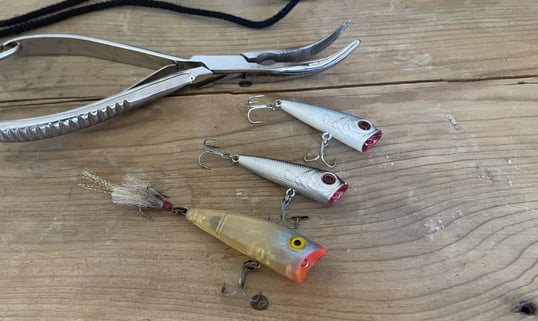
4. Lures or bait: Included in your tackle box or in your bait well, you need something to get the attention of the fish. Artificial lures include flies, spinners, plugs, spoons and more, all designed to attract them, usually by using movements, vibrations, or colors that replicate their prey. Bait can also be used in the same way. If you’re trying to choose between the two, or what the best of either is to use, it’s good to visit a local bait shop and see what bait they’re offering that’s in season, either to stock up or to find out which artificial option would best mimic them.
5. Pocket knife, pliers, and scissors: To complete your tackle box, you’ll need some tools. There will be lines to cut, lures to adjust, hooks to be sharpened or removed, or a hundred other things that may come up on your trip. Having some tools, or even a multi-tool, comes in handy.
6. Nets and gaffs: Whether you’re in a creek bed or far offshore, you’ll want to have some tools to land your catch both safely for you and the fish. When it comes to catching and releasing, nets are vital which you can read more about here . For those large, trophy fish in the deep, a gaff assists you to get some monsters in the boat.
7. Boat or waders: If you’d like to get off the shore or pier and want to stay dry, waders or a boat will help you. Waders are waterproof bibs or boots that keep you warm and dry while you traverse the waves. Boats are great to get out to areas that you just simply can’t reach from land. Use our guide to find out what would be the best boat for your trip here .
8. Sun protection: Hats, polarized sunglasses, and non-spray sunscreen are essential to enjoy your trip and be able to tell everyone about it the next day without wincing through a sunburn. Sunlight reflects off of the water, and it will sneak up on you when you’re too busy enjoying the action. Polarized sunglasses have an added bonus of being able to see through the water and spot fish for some sight casting.
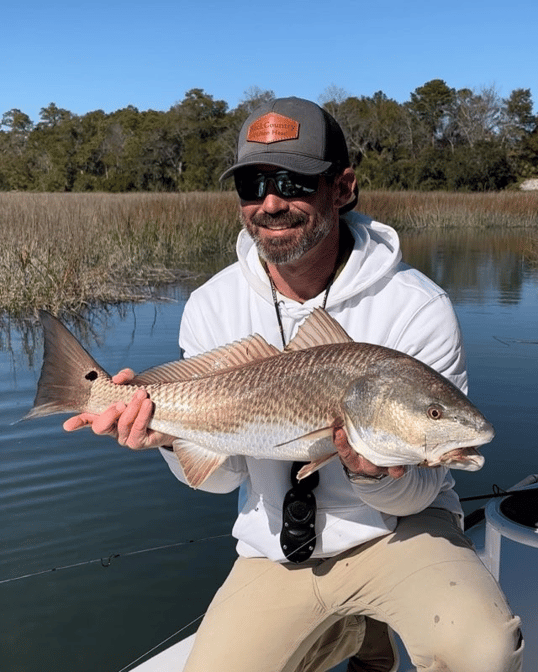
9. Personal flotation devices: If you’re leaving land, having personal flotation devices is extremely important. Not only are they often a legal requirement when you’re on the boat, but for your own safety having life jackets and other emergency equipment, such as a first aid kit, flares, and more can make a vital difference.
10. Cooler, filet knife, and baggies: If you’re choosing to keep your catch at the end of the trip, to cook for a delicious reward after a hard day’s work, you’ll need some tools. Depending on the type of fish, different tools will be helpful, but clean water and a knife are always needed to do the cleaning. Baggies that have a closable top along with a cooler and some ice will keep the fish fresh until you get home and can store them in the freezer. If you’re using a guide, they’ll be able to clean the fish for you, but be sure to keep at least an empty cooler in the car so you can stock up before you make your way home or to a local restaurant that cooks your catch.
Now that we’ve covered all the basics, it’s time to get into all of the fun extras. These are things that won't make or break your trip, but they’re must-haves to make it the best experience possible.
1. Tape measure or scale: Being able to measure and weigh your catch is absolutely necessary if you’re looking to keep your catch, as you need to make sure it is of legal size. However, if you’re just looking to catch and release, it helps to keep track of your personal best, and some accurate bragging rights. Though, when people tell fishing stories, a few inches or pounds are added for every re-telling.
2. Camera: These days, almost everyone has a high quality camera built into their phone, making it an easy thing to pack. Fishing is all about making memories, and having pictures of your day on the water is something to be treasured. Just like the tape measure, it’s also another opportunity to show off your catch to your buddies.
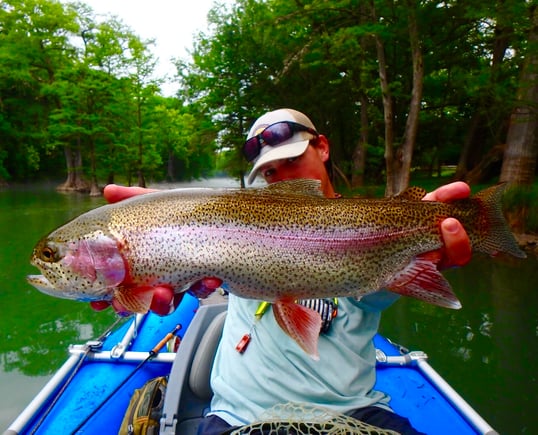
3. Snacks and drinks: When you’re on the water, staying hydrated is vital but often forgotten. Snacks are also important to keep you fueled for an action packed day. Granola bars, crackers, sandwiches, or whatever is your taste can make the difference of coming in early. Of course, a couple cold ones on the boat can add to the relaxation, just be sure not to bring any glass, and have a trash bag for your wrappers, bottles, and cans.
4. Bug Spray: Insects are a quick snack for fish, and you’re a quick snack for them. To avoid spending the entire trip debating on whether or not mosquitos are that important to the ecosystem, spend more time fishing and bring some bug spray.
5. Cash: If you’re going on a guided trip, bringing cash for a tip is customary. Learn more about how much to tip with our guide here . Even if you’re doing your own thing, having spare cash is always a good idea. A quick stop at a bait shop, the gas station, or restaurant on the way home might end up being on the agenda.
What to Wear Fishing
What to wear on a daytrip, what to wear on a fly fishing trip, and what to wear on an offshore trip all have different, but similar answers. What to wear deep sea fishing, especially if you’re planning a multi day trip, will be a little more intensive than simple daytrip clothing. What to wear fly fishing will also vary, not only due to the type of trip, but also depending on the weather. Below are our suggestions on how to be in fashion for any type of trip.
1. Always wear layers. Some of the best times to fish are in the early morning and late afternoon. Starting or ending with a jacket you can rip on and off in a flash is prime to say cozy during your trip. Ripping through the wind on the boat to your fishing spot can also get a little chilly. If you’re on the side of the lake, shedding off a long sleeve on your 20th cast should be able to be quick so you don’t miss the action. Preparation is key and having options is helpful while fighting fish.
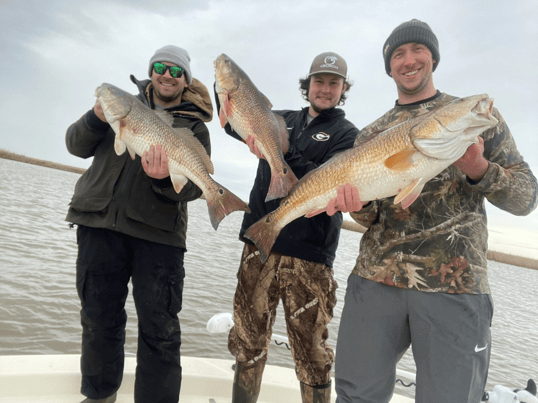
2. Non-marking shoes. Whether it’s your own boat, a buddy’s boat, or a guide’s boat, there’s nothing quite as painful as looking down and seeing a bunch of marks from your black soled shoes. When fighting fish, you’ll want something non-slip so you can have a solid plant, and non-marking so you can leave with awesome memories and zero guilt.
3. Extra set of clothes. If you’re going on a multi-day trip, this may be obvious. However, even on a daytrip, it’s nice to have a spare change of clothes to change into after the trip or even on the way back to shore. Chances are when you’re fishing, you’re probably going to get wet or get some seaweed slime on you. Being able to change into a warm, dry, and clean set of clothes can make all the difference for that after trip dinner spot while you talk about your epic day.
4. Staying comfortable. Fishing is both relaxing and exhilarating, but it certainly isn’t an easy hobby. Battling fish is a lot of effort, and being comfortable will save some aggravation. Along with layers, performance shirts and bottoms are perfect to keep your sweat wicked, dry quickly, and allow you to handle all the action. As Captain Bryce puts it “Making sure you are wearing the correct clothes for a day on the water is of utmost importance. Wearing the incorrect clothes can make a very enjoyable day on the water a very uncomfortable day”
5. Dress for the weather. You can find great fishing in almost any season and any weather if you have the drive. Cold, wind, and rain are all something to consider having to fare on the seas, so bringing a windbreaker or rain jacket is always a good idea. For a complete guide on what to wear on a fishing trip depending on the weather and season, check out our advice here .
Hitting the Water
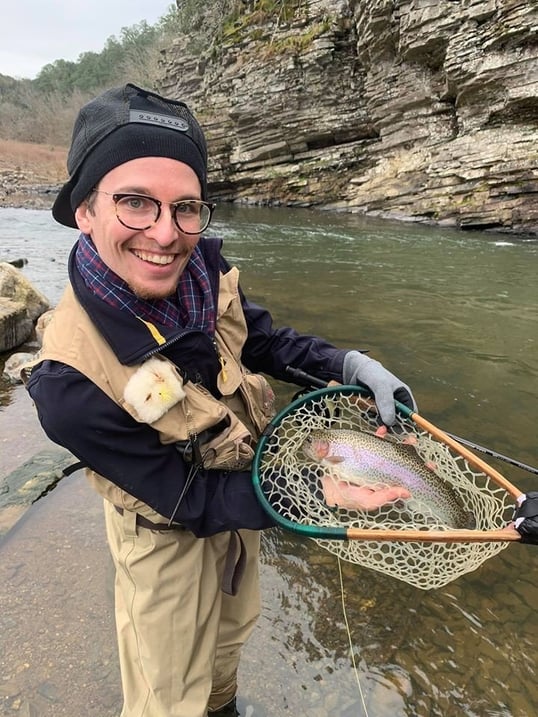
That’s a pretty long checklist, odds are you’ll probably forget to bring something. Not to worry though, as Captain Walter likes to say, the most important thing you can bring is confidence. Staying positive and having a good time is what it’s all about. Whether you’re going on a guided trip and only have to bring yourself, or you’re going on a multi-day solo kayaking adventure these are the necessities to get you started.
Shawna Stowers
Updated on August 2, 2023

April 15, 2022

March 8, 2022

April 26, 2022

June 3, 2021

January 7, 2022
Related Articles

April 6, 2021

April 10, 2022
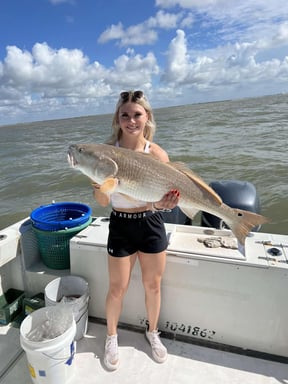
June 15, 2023


Fishing Charter: A Checklist Of Everything You Need To Bring For Your Trip
You have been travelling the entire day and you have finally made it. You are finally in the beautiful place of Myrtle Beach and you’re all set for your vacation. Your days here are filled with excitement but the one activity that you are looking forward to is to head out into the open ocean together with an experienced and professional deep sea fishing charter . But you have one problem! You have no idea what you have to pack.
Don’t worry. Whether you are a beginner or an experienced angler, here’s a few tips on what you need to bring on a fishing charter.
What do you need to wear?
When you head out onto Myrtle Beach’s beautiful open waters, you should remember that the weather can easily change. You need to be comfortable when you are hauling in your catch.
- Rain gear or windbreaker – these are important in protecting you from sea spray to downpours. They will keep you warm in case you feel a bit chilly during the early morning.
- Light clothes – a T-shirt, shorts, or a light long sleeve shirt will help keep you cool.
- Hat – this will keep your head cool and the sun’s bright light out of your eyes.
- Polarized sunglasses – This will help protect your eyes against the glare of the water.
Don’t Forget Your Sunscreen
The sun’s strength must never be underestimated even if the day seems cloudy. You wouldn’t want your day out on a fishing charter Myrtle Beach to be ruined because of a sunburn. You are going to be wincing each time you cast. The sun’s reflection of the ocean is nice to look at but it will have a negative effect on your skin.
- Check the sunscreen’s SPF. It should have at least SPF 50.
- Bring your chapstick or lip balm. It will help prevent your lips from getting chapped out or burnt on the water.
- Your nose may look funny with it. But if lifeguards wear them, why don’t you?
Deep Sea Fishing Preparation: Bring Your First Aid Kit
When talking about the ocean waves, the “don’t rock the boat” phrase don’t apply. You can make sure that your fishing trip is comfortable and safe by packing your first aid kit.
- If your stomach easily gets upset by ocean waves, then you have to bring your motion sickness medication.
- Don’t forget to bring some extra band-aids.
- Bring a hand sanitizer to make sure your hands are clean.
What food should you bring when going on a deep sea fishing trip?
Everyone has to eat and in the hot sun, you need to make sure that you are hydrated. Here are a few tips and fishing snacks you can bring. Please note that Voyager Deep Sea Fishing & Dolphin Cruises has food and drinks on board for purchase. But it’s always a good idea to bring some of your own.
- Large water bottle or thermos
- Jerky, granola, chips, and other snacks
Voyager Deep Sea Fishing & Dolphin Cruises will take care of all the other crucial requirements before going out in the open water. We’ve got the fishing license, the bait, camera, ice and the cooler, too.
If you are thinking of going on a fishing trip in Myrtle Beach, call Voyager Deep Sea Fishing & Dolphin Cruises now.
Voyager Deep Sea Fishing & Dolphin Cruises 1525 13th Ave N North Myrtle Beach, SC 29582 (910) 575-0111 (843) 626-9500 http://supervoyagerdeepseafishing.com/
- private charter fishing
- fishing charter
- Fishing Charter Myrtle Beach
- fishing trip

What should I pack for a 60 hour, overnight trip?
Aug 14, 2022 | Tuna Club , Uncategorized
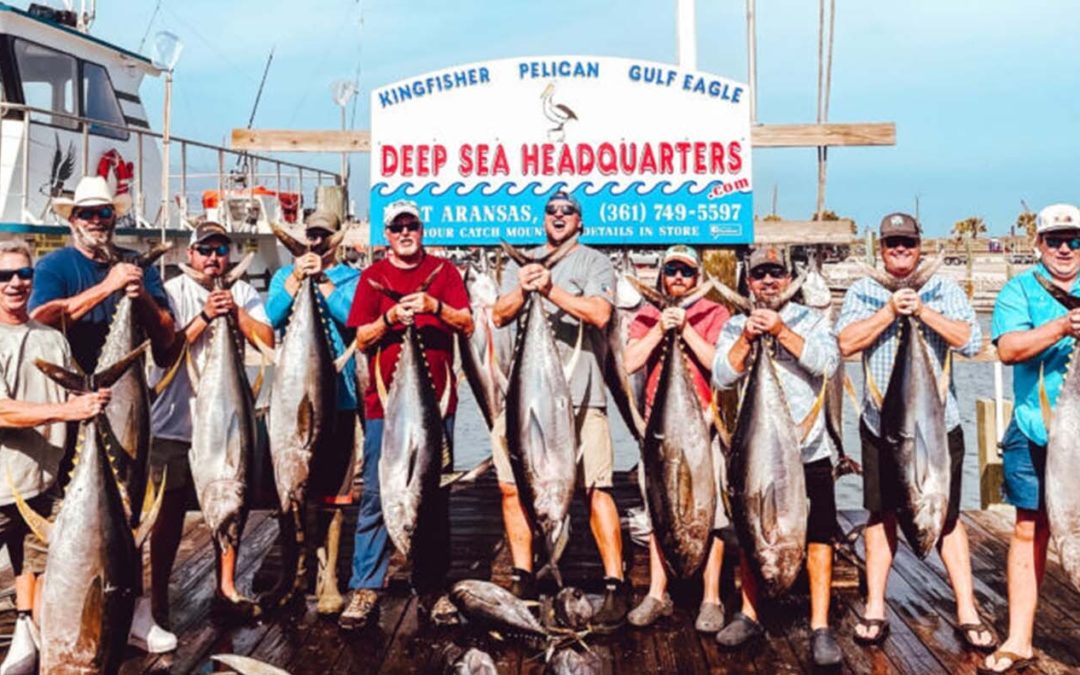
EAT · SLEEP · FISH · REPEAT
The 60 Hour Trip is the ultimate experience for the serious angler! Head out on an overnight adventure to chase monster yellowfin tuna and wahoo at the Flower Gardens. We set you up with the best opportunity to catch fish of a lifetime.
Are you ready to EAT · SLEEP · FISH · REPEAT?
Anglers are required to bring their own food and drink for the duration of the 60 hour trip. Pack a personal cooler no larger than 48 quarts with everything you need to nourish your body and feed your adventurous soul. A microwave is available onboard. Don’t forget drinking water!
❌ NO LIQUOR
Anglers are required to bring personal bedding. Empty bunks are stripped down and ready for your personal sleeping bag, pillow, and an optional extra blanket.
What else should I pack?
Appropriate clothing for the weather, an extra change of clothes and shoes, extra jacket, and a hand towel.
❗️Pro Tip: Although not required, a great pair of water-resistant shoes, like Xtratufs, can make your trip more enjoyable. Soggy shoes can put a damper on even the most exciting experience. Stop in the store at Deep Sea Headquarters to try on a variety of Xtratuf styles.
Everyone 17 and older must have a valid Texas saltwater fishing license.
Rods, reel, bait, and some tackle will be provided but you are welcome to bring your own gear. Anglers are encouraged to bring 3-5 jigs, to increase their chances for success. We do have 6–10oz jigs available for sale in the store.
Optional tackle
- Poppers (130 Halco: Bonita, Pilchard, etc.)
- Artificial Flying Fish (Pink or Blue)
- Rod and reel you can cast, spooled with 50lbs test
Now that you are headed home with your catch and a heck of a story, what’s next? Tip your crew , take pictures at our fish hanging station, arrange to get your fish cleaned and/or mounted, and book your next adventure!
TIPS –Your crew worked hard to rig bait, spool rods, put you on the fish, gaff and store your catch, and encourage a professional and positive experience. Each angler is encouraged to tip 15–20% of the cost of the trip.
CLEANING –Fish cleaning is available upon return at the fish house conveniently located at Deep Sea Headquarters. CASH ONLY.
MOUNTING –Fish mounts are a great way to remember an epic catch but several measurements and pictures need to be recorded BEFORE the fish is cleaned. Head straight into the store at Deep Sea Headquarters to inquire about taxidermy mounting services.
Join the Port A Tuna Club
Get exclusive membership perks!
Email Address
Mailing Address
Long-range Trip Experience Long-range Trip Experience None 24 Hour 36 Hour 60 Hour
Phone Number
Would you like to receive text messages about last minute tuna trip availability? Would you like to receive text messages about last minute tuna trip availability? Yes No
- Catch of the Week
- Species Highlight
- Uncategorized

Login to my account
Enter your e-mail and password:
New customer? Create your account
Lost password? Recover password
Recover password
Enter your email:
Remembered your password? Back to login
Create my account
Please fill in the information below:
Already have an account? Login here
Your cart is empty
Beginners Checklist for Deep Sea Fishing

- Cash for cleaning fish, food, and other things on the boat. Try to bring smaller bills for tipping.
- Rod, Reel, and Line (You can always rent or bring your own)
- Your favorite snacks.
- Sunblock (You will need this since you will be out on the open seas)
- Sunglasses
- Towels or small heavy-duty tissues.
- Camera (Though DSLRs are great, a quality point and shoot or GoPro will be most convenient)
- Seasickness medication. You want to get a good night sleep prior and no heavy food for breakfast to help reduce your sea sickness.
- Water. Though you are not moving much it is always good to stay hydrated.
- Ice Chest with Ice (to bring your fish back fresh)
This list should cover most of your needs and wants on a fishing trip. Go out there and catch some fish. We are confident you will enjoy your time and will want to pursue this awesome lifestyle.
Leave a comment
All comments are moderated before being published
A short sentence describing what someone will receive by subscribing
100% free, Unsubscribe any time!
Subscribe to our newsletter
We send product updates, Fishing Tips, and exclusive deals.
Unsubscribe at any time.
Free delivery
No cost on delivery in the continental U.S.A. on all products
3 Year Warranty
All Coastal Products come with a full 3 year warranty
Product Support
Speak to our seasoned support crew members
Secure payments
Payment information is protected by a secure gateway
- Opens in a new window.
JavaScript seems to be disabled in your browser. For the best experience on our site, be sure to turn on Javascript in your browser.

- SUMMER SALE - UP TO $400 OFF Shop Now
Free Shipping valid only within the contiguous USA.
Beginner's Guide to Deep Sea Fishing

Share this post
Deep sea fishing, also called offshore fishing, can bring a whole new meaning to “out of one’s depth”. If you're just starting out and feel like you're a little in over your head, don’t worry – this guide will reel you up to the surface.
In this beginner’s guide to deep sea fishing, we will cover how to prepare for a deep sea fishing trip, equipment and gear you need to go deep sea fishing, and tips and tricks for deep sea fishing.
Preparing for a Deep Sea Fishing Trip
Deep sea fishing is as it sounds, fishing in deep waters typically around depths of 100 feet. To reach these depths, you need to go miles offshore, usually somewhere between 50 and 100 miles out. This is where you’re going to find replica-worthy fish, such as marlin, but also new challenges. These challenges require different preparations before you head offshore, so here’s what you need to do to get ready for a deep sea fishing trip.
Preparing a Boat for Deep Sea Fishing
When you go as far offshore as you need to for deep sea fishing, you absolutely need to have a boat that can handle the waters. For a boat to have the strength and stability it needs to handle open water and big game fish, it should be at least 35 feet long. Center console boats are a common boat for these offshore trips, and many fishermen recommend having two engines for extra safety.
You’ll also want to outfit your deep sea fishing boat with a t-top canopy and extension . It can take hours just to get to an offshore location, so having protection is essential. A t-top provides a shield from UV rays and can offer shelter from the rain. Adding a shade extension is recommended to cover more surface area of your boat. Of course, this equipment doesn’t replace wearing appropriate clothing, so always dress for the occasion.

Safety Requirements for Deep Sea Fishing
First and foremost, you need to make sure that you’re prepared for anything before you head offshore. When you’re fishing over deep waters, you’re far away from getting any help you might need. Your number one priority should be emergency preparedness. If you’re not sure what you will need, check out our comprehensive guide on fishing first aid . Here, you’ll learn what supplies should be in a medical kit, what injuries or emergency situations you might encounter, and how to handle them.
When you go this far offshore, however, there’s only so much you can do to be prepared. If possible, have someone on board that’s received medical training, and always do your research on emergency contacts and protocols for where you’ll be so you’re familiar with them and know what to do should an emergency arise.
Safety Equipment and Gear for Deep Sea Fishing
In addition to a first aid kit, appropriate clothing, and protection from the elements, you’ll want to have these other items on board and at the ready:
- Emergency position indicating radio beacon (EPIRB)
- Fire extinguisher
- GPS and navigation charts
- Personal flotation devices (at least one for each person on board)
- Shoes with rubber soles
- Signaling devices
- VHF marine radio
This might sound like a lot, especially when you need to add fishing gear to the list, but it’s always better to have something and not need it, than to need it and not have it. You want to keep most of these items in a location that you can access quickly and easily. We recommend the t-top storage bag and electronics box for convenient, water-resistant, and durable storage solutions.
Fishing Gear for Deep Sea Fishing
After you check off all necessary safety items from your packing list, it’s time to turn your attention to the fun part – fishing. There’s a lot we could say about deep sea fishing, and saltwater fishing more generally, but here we’re going to focus on the basics. If you’re looking to delve deeper into saltwater fishing, we recommend checking out our how-to guide to saltwater fishing . Our offshore saltwater fishing guide is also a great resource to take the information we’ve given you here to the next level.
Fishing Rod and Reel for Deep Sea Fishing
When you go deep sea fishing, you’re targeting big game fish species. Some popular species for deep sea fishing include Mahi Mahi, Wahoo, Tuna, Snapper, Grouper, and (for the thrill-seekers or occasional unsuspecting fisherman) Sharks. These fish are large, heavy, and strong. Be prepared for long and tiring, but exciting fights, and bring a fishing rod and reel that are up to the task.
You probably already know this if you are a more experienced fisherman, but your rod and reel are largely determined by the fish you’re targeting, and where and how you’re fishing for it. For deep sea fishing, you’ll want to bring a 7-8’ rod with medium/heavy action, and a reel that can hold an 80-lb. test line with a 50-lb. drag. Generally speaking, the larger the fish, the longer the rod, and the stronger the fish, the stronger the line.
Deep Sea Fishing Packing List
In addition to your rod and reel, you’ll need all your standard fishing gear, including line, hooks, and bait. You’ll consider the same things for these as you did for your rod and reel. We have a separate guide for choosing saltwater fishing bait, and a more in-depth guide for saltwater fishing gear than what you’ll see here. For a quick, basic packing list, here’s what you need for deep sea fishing:
- Braid scissors
- Cooler with ice, food, and drinks
- Fishing knives
- Fishing license(s)
- Hook remover
- Landing nets
- Lip-grippers
- Long-nose pliers
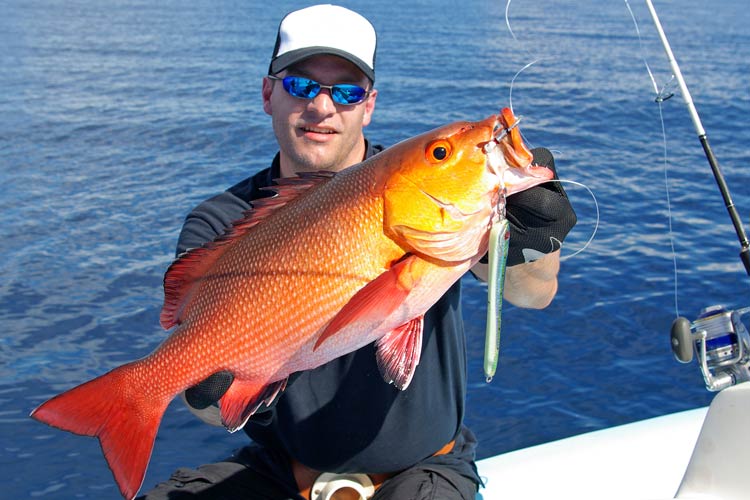
Tips and Tricks for Deep Sea Fishing
Now that we’ve covered the basics, we’ll leave you with three tips and tricks to think about as you prepare for your deep sea fishing trip.
- Know when to go deep sea fishing. Once you have a target fish in mind, go online and find information about it. Where does it eat? What does it eat? When does it eat? Where can you find it? These are crucial questions to ask to help you figure out when you should go fishing.
- Know your fishing techniques. Not only should you know when and where to fish for a target species, but also how. There are many fishing techniques, and some are more effective for certain fish species than others. Part of your online research should include learning what technique has better results.
- Have fun! This one is obvious, but remember that fishing is about enjoying it. We know the disappointment of missing out on a trophy fish, but that’s not really what deep sea fishing is all about. When you’re out there, take a moment to soak it all in and appreciate the experience.
Please log into your account to post comments

- News
- General
- How-To

What To Take On A Fishing Trip? My Top 25 Essential Items
Not sure what to take on a fishing trip? My list of all the essential items includes everything you'll need for a successful fishing adventure.
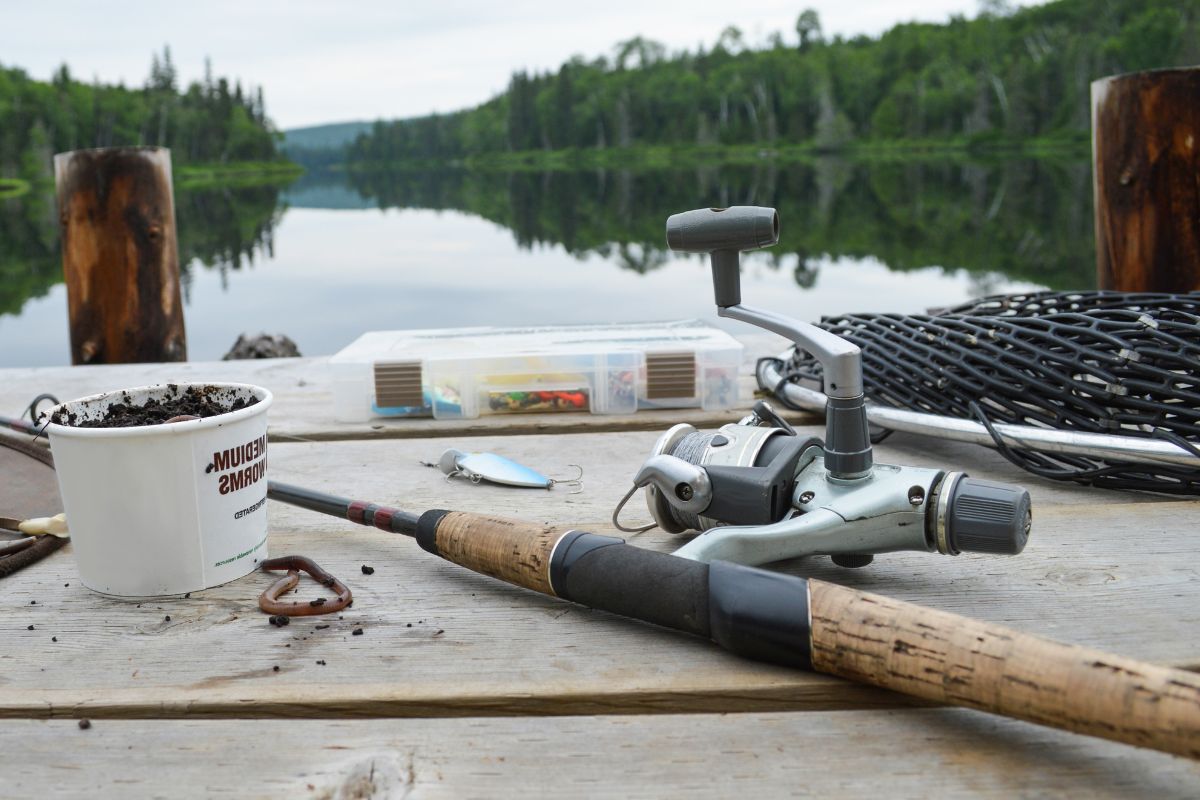
The Outdoor Authority may receive commissions for links included in articles to affiliate partners. Each of our recommendations is proudly backed by research and testing.
Going fishing is truly one of life’s great pleasures.
Tossing a line into the water and pulling a fish from the depths beneath you unlocks a primal and mystical feeling in anyone who experiences it.
But as someone who has gone fishing without the proper equipment more than once, I can say with absolute certainty that fishing is way more fun when you’ve got the right gear.
If you’re not sure what to take on a fishing trip , don’t stress! You won’t need to break the bank and can get started with just a few basics.
I’ll share with you my checklist of essential items to take on any fishing trip and break it down based on the type of fishing you might be doing.
Let’s go fishing!
Table Of Contents
A Fishing Pole & Reel (aka Rod & Reel)
Fishing line, bait and lures, polarized sunglasses, fishing license, life jacket, first aid kit, sunscreen and bug spray, proper clothing, snacks and water, extra layers of clothing, hand warmers, ice fishing auger, ice fishing sled, sun-protective clothing, water shoes, portable fan, appropriate clothing, non-marking shoes, waterproof bags, motion sickness medication, what to take on a fishing trip: final thoughts, essential fishing equipment and tackle.
You don’t need much to go fishing but at the bare minimum you’ll need a fishing pole, some line, a hook, and some bait. Let’s take a closer look at each of those plus a few other pieces of gear that I personally consider essential.
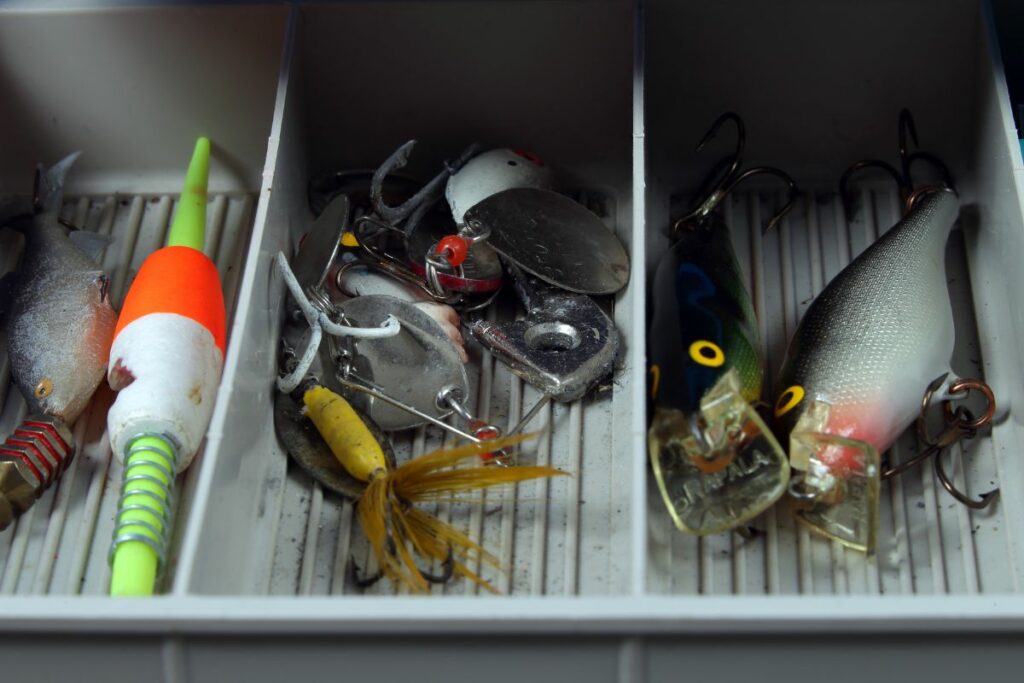
You can use almost anything as a fishing pole. It could be something as basic as a cane pole or piece of bamboo or as advanced as an ultralight carbon fiber rod made from space-age materials.
You’ll also need a reel to attach to your pole, and the good news is that there are tons of great fishing poles that come with reels already attached to them.
The type of rod and reel you choose will be highly dependent on the type of fishing you’re doing, so I have to keep my recommendations somewhat board but these two are good places to start:
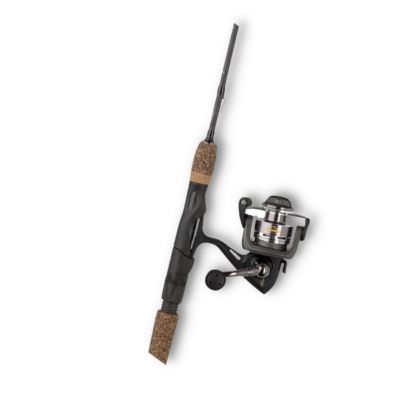
FRESHWATER ROD & REEL COMBO
Lightning Rod Spinning Combo
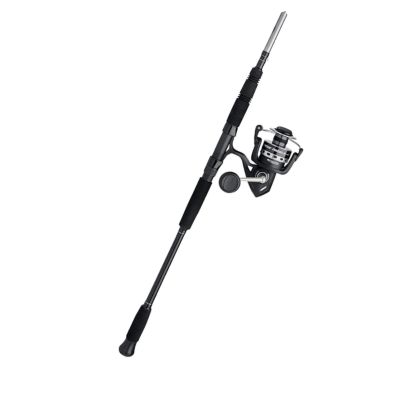
SALTWATER ROD & REEL COMBO
Pursuit IV Spinning Reel & Rod
I like the Berkely Spinning Rod and Reel Combo as a great starter set for freshwater fishing and lakes and the PENN Pursuit IV is my pick for saltwater fishing from shore.
There are a variety of fishing lines available, each designed for specific fishing techniques and target fish species. Choose the appropriate weight, thickness, and material based on what type of angling you’ll be doing.
When it comes to selecting the right fishing line , it’s essential to consider its strength, sensitivity, and abrasion resistance.
Monofilament is an excellent all-purpose choice for many anglers due to its versatility and affordability. Fluorocarbon lines offer better visibility underwater while still providing excellent abrasion resistance, making them perfect for clear water situations where stealth is crucial.
My advice: Don’t skimp on the quality of your fishing line. It’s literally the only thing between you and a successful catch!
If you thought a hook is just a hook then you’re in for quite a surprise.
Hooks come in all sorts of shapes and styles, each suited to different types of fish and bait. It’s important to research beforehand to determine which hooks will work best for the type of fishing you’ll be doing.
So where to start? Look for self-setting hooks or circle hooks. But hooks are cheap so it’s useful to include a variety of sizes in case you encounter different species or water conditions.
Live bait such as worms, minnows, or crickets work well for many species of fish. Artificial lures like spinners or jigs mimic natural prey and can also be effective.
While live bait may require refrigeration and can be a bit messier than artificial lures, the advantage is that they offer a scent and movement that attracts fish.
Using an appropriate lure depends on factors such as water depth, clarity, temperature, and weather conditions. Try different baits until you find the one that works best for your fishing location and target species.
A tackle box is useful for keeping all your lures, lines, and miscellaneous fishing gear organized and in an easy-to-grab that is ready whenever you want to go fishing. You can find Tackle Boxes on Amazon, Walmart, or nearly any sporting goods store.
You can also DIY a Tackle Box out of other boxes or bins you might have laying around your house. My grandfather fished nearly every day off of his life and he used an old toolbox and a few used coffee containers to all his tackle storage needs.
I highly recommend getting a good pair of polarized fishing sunglasses . Polarized sunglasses provide better visibility while fishing and make it easier to spot fish even on cloudy days.
They also protect your eyes from harmful UV rays. This can help prevent eye strain and damage caused by long hours of direct sunlight exposure.
So whether you’re planning a day or weekend fishing trip, make sure to add polarized sunglasses to your checklist of essential items. Trust me, you won’t regret having them with you!
If you’re an adult you very likely need a fishing license and if you get caught fishing without one you risk getting fined or even jailed in extreme situations.
Each state, country, and area has their own regulations so I recommend Googling to see what laws are present in your area and what licenses you might need.
Be aware that different types of fishing can require different licenses. For example, in my home state of Florida, we have different licenses for freshwater and saltwater and even have special permits required for some species of fish.
Safety And Comfort Items
If you’ve got the item above, you’re ready to catch fish. But to make your fishing trip safer and more enjoyable I recommend these items as well.
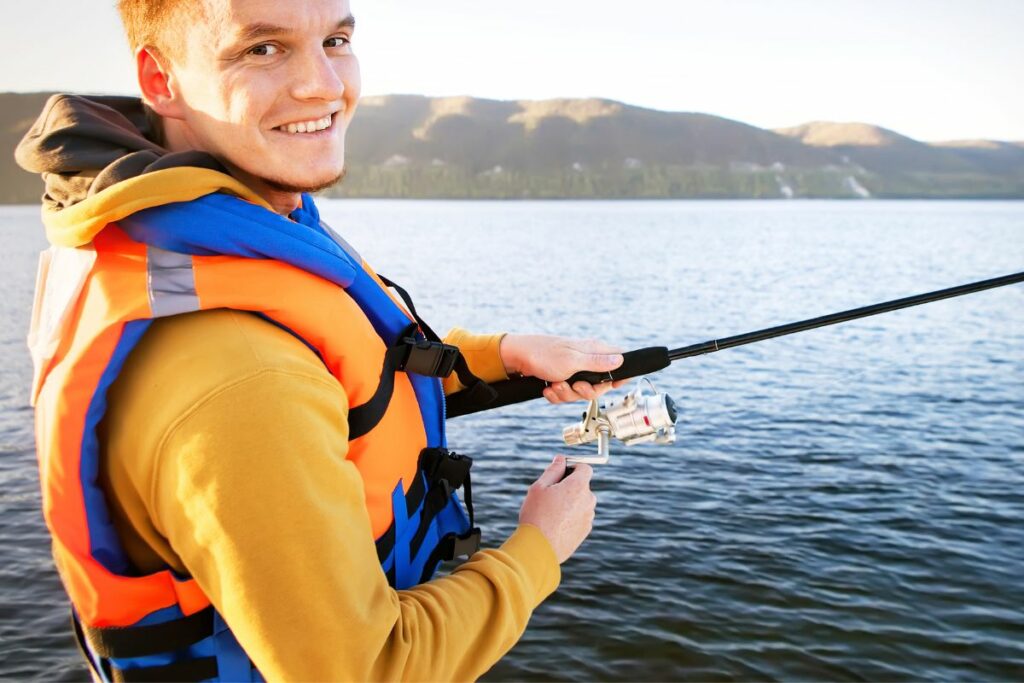
If you’re going to be fishing from a boat then a life jacket is a must and even mandatory in many locations.
However, If you’re fishing from the shore a lifejacket isn’t required but they are a good idea for children or anyone who isn’t a strong swimmer.
I always make sure to pack a well-stocked first aid kit when I go on a fishing trip.
It’s important to be prepared for any possible injuries or emergencies that could happen, especially if you’re going on a longer trip or are in more remote areas. Some essential items to include in your first aid kit are adhesive bandages, antiseptic wipes, gauze pads, medical tape, and tweezers.
The sun can be intense while out on the water, so applying sunscreen with at least SPF 30 is important for protecting your skin. Bug spray is also a must-have item to keep those pesky mosquitoes away .
When choosing a sunscreen, opt for one that’s waterproof and sweat-resistant to ensure it lasts throughout the day. Apply it before leaving shore and reapply every few hours or after swimming.
For bug spray, choose one with DEET as an active ingredient for effective mosquito repellent.
Hats with wide brims are particularly suitable as they provide extra protection from the harmful rays of the sun while keeping you cool. Having some shade also helps cut through the glare of the water and make fish a little easier to see.
A hat can also help to keep you dry in case of unexpected rainfall, reducing your chances of catching a cold or getting sick. Whether it’s sunny or raining, make sure to pack a good quality hat that provides ample coverage over your head and neck.
In colder climates, it’s recommended to wear multiple layers of clothing, including thermal underwear and a waterproof jacket. It can get much colder on the water than it does on shore, so if you’re fishing from a boat I recommend planing accordingly.
On warmer trips, lightweight and breathable sun-protective clothing are ideal. I’m personally a big fan of Columbia Performance Fishing Gear shirts which are moisture-wicking, ventilated, and comfortable.
Another important factor in dressing properly is footwear. Wearing sturdy boots with good traction can prevent slips and falls when fishing near water or on slippery rocks. But boots are a big no-no on boats! Instead where shoes with non-marking soles if you’ll be fishing from a boat.
A backup pair of socks is a good idea too if you’re not a fan of wet feet.
When packing for a fishing trip, snacks and water are often overlooked but are essential for staying hydrated and energized throughout the day. It is important to bring enough water to stay hydrated, especially on hot days when dehydration can be dangerous. Snacks like trail mix or energy bars provide quick fuel during breaks while fishing.
A cooler serves two dual purposes when fishing:
- Keeps you water and snacks cold
- Keeps any fish you caught fresh until you can clean them
If you’re going off shore or on an extended trip then I recommend investing in a premium fishing cooler. But if you’re just heading down to a local lake or river for an afternoon of fishing then any cooler you already own will do just fine.
Gear For Fishing In Cold Climates
When fishing in colder temperatures, it’s important to bring extra layers of clothing, hand warmers, and an ice fishing auger. But that’s not all! Keep reading for more essential gear to make your cold climate fishing trip a success.
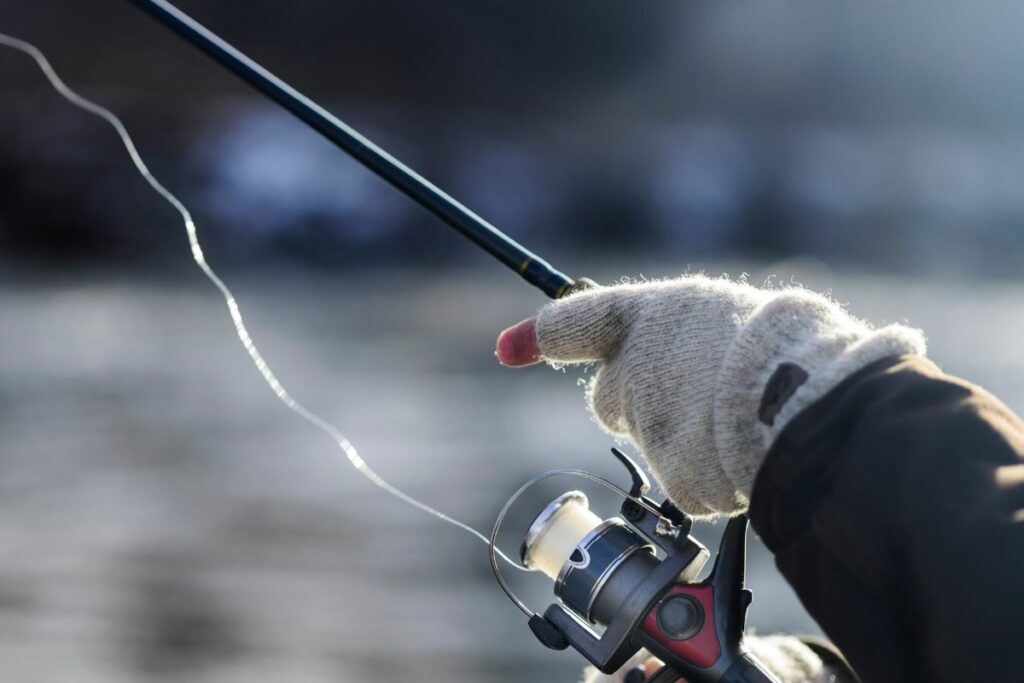
Even if the weather forecast looks mild, temperatures can drop quickly on the water or during early morning hours. Packing thermal underwear and insulating jackets are always good ideas to ensure you stay warm throughout your trip.
It’s also wise to pack rain gear even if precipitation isn’t predicted. Heavy rain can happen suddenly when out on the water, so be prepared with waterproof jackets and pants to stay dry and comfortable. Remember that being cold or wet can make for an unpleasant fishing experience, so bring those extra layers just in case!
I always make sure to pack hand warmers on my trips. When your hands get cold, it can be difficult to handle your equipment and even start a fire. These small packets of heat are easy to use – just shake them up and they’ll provide warmth for hours.
If you’re going to be fishing from a shorline you may want to consider getting a pair of waders. Waders will keep your feet dry and even provide you with the opportunity to walk out into the water for easier access.
Related: Simms vs Orvis Waders: A Fisherman’s Dilemma
If you’re ice fishing, and Auger is a must-have item. It’s the only way to break through the ice so you can drop your line and catch fish. With different sizes available, make sure to choose one that fits your needs based on the thickness of the ice.
In addition to selecting the right size, it’s important to consider the weight and durability of an ice fishing auger. You’ll want something sturdy enough to handle drilling through thick layers of ice without weighing you down too much during transport.
An ice fishing sled allows you to easily transport your gear across the ice and can also be used as a base for setting up your equipment.
Not only does an ice fishing sled make it easier to carry your gear, but it also helps distribute your weight more evenly on the ice. It’s important to note that not all sleds are created equal – make sure you choose one that is sturdy and can withstand heavy loads.
Gear For Fishing When It’s Hot Out
For fishing trips in warm climates, it is important to bring sun-protective clothing, water shoes for wading into the water easily, a portable fan to keep cool on hot days, and ice packs to keep food and drinks cold.
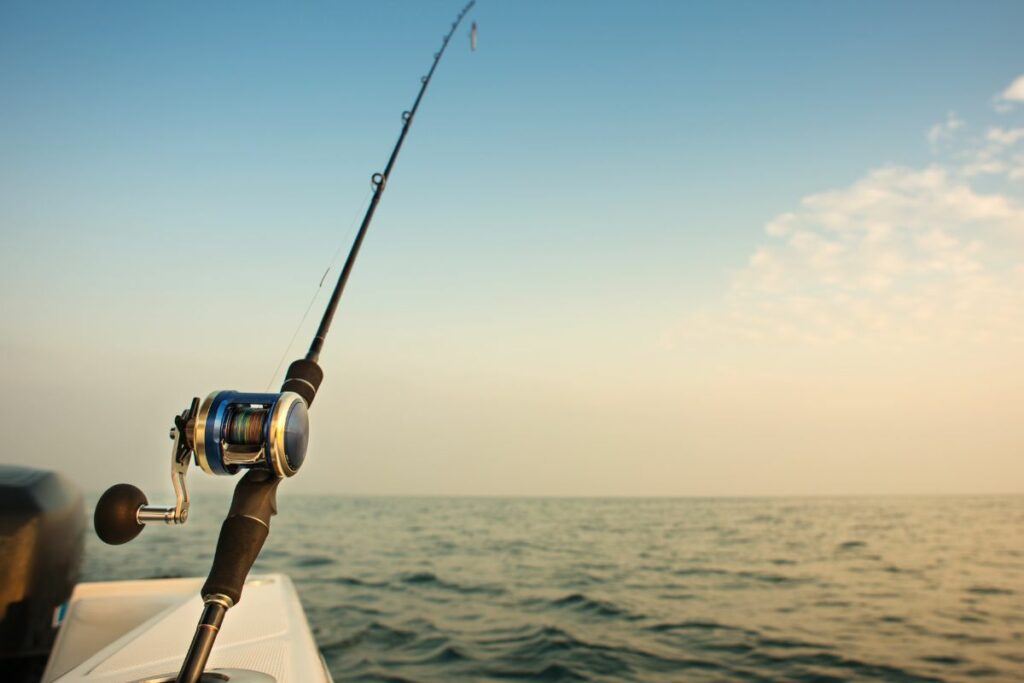
When going on a fishing trip in warm climates, sun-protective clothing is crucial to ensure you don’t suffer from the effects of UV radiation. You should dress in light-colored and loose-fitting clothes that provide ample coverage for your arms, legs, and neck. A long-sleeved shirt with UPF protection can block much of the harmful rays of sun exposure.
Water shoes are an essential item to bring on a fishing trip, especially if you plan on wading in the water. They provide traction and prevent slipping on wet rocks or muddy riverbanks. Make sure to choose a pair that is comfortable and fits well, as you’ll be wearing them for extended periods of time.
In addition to providing safety while walking in water, water shoes also protect your feet from sharp objects or any other potential hazards underwater. They can also be worn when boating or kayaking, offering protection against slipping on wet surfaces. Overall, investing in a good quality pair of water shoes will make your fishing experience more comfortable and enjoyable.
When going on a fishing trip in warm climates, it’s important to stay cool and avoid heat exhaustion. A portable fan is a great item to pack, as it can provide much-needed relief from the sun’s rays. It’s especially useful when there isn’t a breeze or shade available. I prefer a portable battery-powered fan since it’s rare that you’ll be fishing near a power source.
I always make sure to pack ice packs for my cooler. It’s important to keep your catch as fresh as possible, and ice packs help to do just that. Plus, they’re great for keeping snacks and drinks cold on those hot days.
Ice packs can also be useful for treating minor injuries while out on a fishing trip. If you happen to get hurt or experience swelling from a bug bite or sting, applying an ice pack can provide some relief. Just make sure to wrap the ice pack in a towel or cloth before placing it directly on your skin to avoid any potential frostbite.
What To Bring On A Deep Sea Fishing Charter
Going on a deep sea fishing charter with an experienced guide is a fantastic way to get your first introduction to fishing. The guide takes care of all the hard work and typically does a good job of helping you catch your first fish. The good news is you usually don’t need to bring much with you, but there are a few things to be aware of.
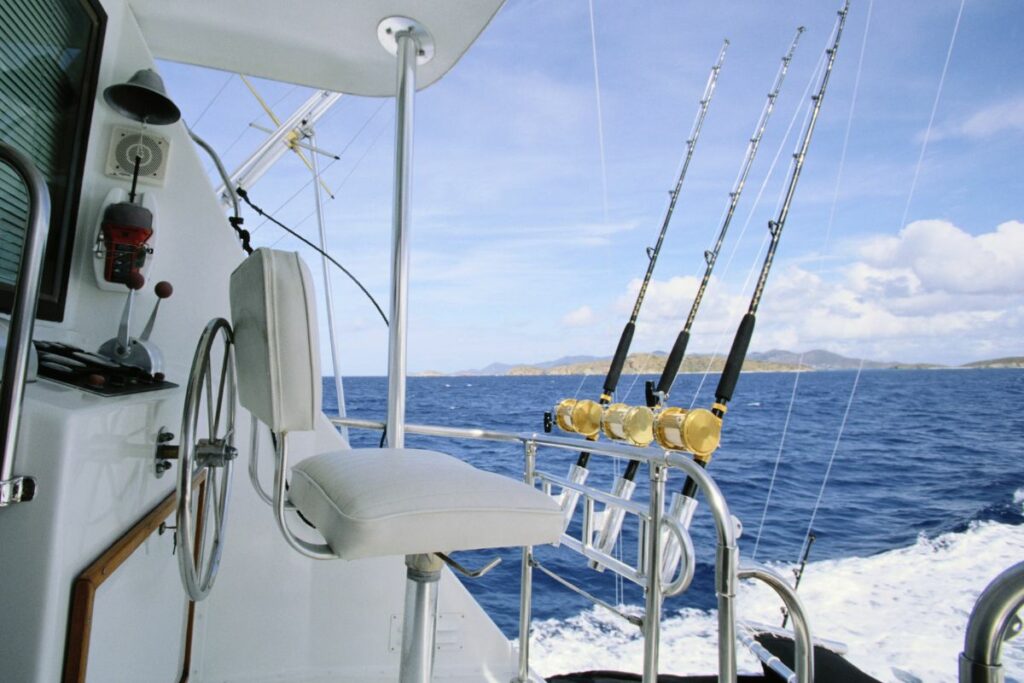
I already mentioned clothing earlier in the article but I want to stress it again here. If you’re going to be in direct sunlight all day, it’s essential to wear protective clothing like long-sleeved shirts, pants, and hats. Sunscreen is also essential.
Additionally, wearing waterproof and breathable clothing can help keep you dry if there are waves or rain during your trip. Bringing extra layers such as a jacket or sweater is also advisable in case it gets cold or windy out on the water. Keep in mind that some fishing trips require specific clothing for safety reasons so check with your charter operator before packing your bags.
The number one rule for fishing from any sort of offshore boat is that you can’t wear shoes with dark soles that will leave a mark on the deck of the boat. Fortunately, most regular athletic shoes will be fine and you won’t need to buy anything special just for your trip.
I always make sure to pack a waterproof bag when going on fishing trips. This is essential for keeping my belongings dry in case of rain, waves, or accidental splashes while on the boat. It’s also great for storing fish or bait that can be messy and stinky.
When packing a waterproof bag, I always make sure to double check that it is actually waterproof and not just water-resistant. I prefer bags with zippers or roll-top closures to ensure nothing falls out. It’s a small but crucial item to bring on any fishing trip to ensure everything stays safe and dry throughout the day.
Getting seasick is THE WORST so I always make sure to have motion sickness medication with me whenever I go offshore. The constant movement of the boat can be difficult for some people to handle. Taking motion sickness medication beforehand can prevent any discomfort and ensure an enjoyable trip.
Do NOT Overpay For Camping and Outdoor Gear
We Find The Best Deals & Discounts Online And Share Them With YOU
Whether you are a seasoned angler or just starting out, using a fishing checklist can help make sure you have everything you need before leaving home. And don’t forget to bring plenty of snacks and water – after all, what’s better than enjoying some fresh-caught fish with friends or family?
So pack up your gear, hit the road, and get ready to reel in some memories on your next fishing adventure!

Thomas Coleman
The Outdoor Authority
Follow Us: Facebook / Instagram / YouTube
TheOutdoorAuthority.com is a participant in the Amazon Services LLC Associates Program. As an Amazon Associate, we earn from qualifying purchases by linking to Amazon.com.
© 2024 TheOutdoorAuthority.com
What to Bring on Your Deep Sea Fishing Trip: A Checklist
Fish That Eat Algae: A Comprehensive Guide
The ultimate guide to fishing in punta cana: an unforgettable adventure, the fascinating world of the fishing cat: a deep dive into an extraordinary species, the ultimate guide to hunting recreation in hawaii, introduction.
Deep sea fishing is an adventure like no other. With the vastness of the ocean and the thrill of the catch, it’s no wonder why so many people flock to the waters for a day out on the boat. But before you head out to sea, you need to make sure you’re properly prepared. Packing the right gear and equipment is essential for a successful trip. In this article, we’ll provide you with a comprehensive checklist of what to bring on your deep sea fishing trip.
Fishing Gear
Your fishing gear is the most important part of your trip. Without it, you won’t be able to catch any fish. Here’s what you’ll need to bring:
- Rod and reel
- Fishing line
- Lures and bait
- Hook remover
- Fishing net
- Fish scaler
- Fishing gloves
- Sunscreen and sunglasses
The ocean can be unpredictable, and the weather can change quickly. Make sure you pack the right clothing to stay comfortable during your trip. Here’s what you’ll need:
- Lightweight, long-sleeved shirt
- Rain jacket
- Warm jacket or sweater
- Waterproof pants
- Non-slip shoes or boots
- Extra socks
Safety Equipment
Safety should always be your top priority when out at sea. Make sure you have the following safety equipment on board:
- Life jackets for every person on board
- First aid kit
- Fire extinguisher
- Emergency whistle
- Waterproof flashlight
- Personal locator beacon
Food and Drinks
Fishing can be tiring work, so it’s important to bring enough food and drinks to keep your energy levels up. Here’s what you’ll need:
- Bottled water
- Sports drinks
- Energy bars or trail mix
- Sandwiches or other easy-to-eat foods
- Cooler with ice
Miscellaneous Items
There are a few other items you’ll need to bring to make your trip more comfortable and enjoyable. Here’s what you’ll need:
- Camera or GoPro
- Hand sanitizer
- Insect repellent
- Fishing license
- Cash for tips and other expenses
Q: Do I need a fishing license for deep sea fishing? A: Yes, you’ll need a fishing license for deep sea fishing. Make sure you obtain one before your trip.
Q: Can I bring alcohol on my fishing trip? A: It depends on the charter company. Some allow alcohol in moderation, while others prohibit it entirely. Check with your charter company before bringing any alcohol on board.
Q: Can I bring my own fishing gear? A: Yes, you can bring your own fishing gear. However, most charter companies provide gear for their customers, so it’s not necessary.
A deep sea fishing trip can be an unforgettable experience. But to make the most of your time on the water, it’s important to come prepared with the right gear and equipment. Use this checklist to ensure you have everything you need for a successful and enjoyable trip. And remember, safety should always be your top priority when out at sea.

LEAVE A REPLY Cancel reply
Save my name, email, and website in this browser for the next time I comment.

Exploring Utah’s Captivating Hunting Destinations
The art and adventure of fishing with john: an unparalleled experience, 10 delicious camping recipes that will impress your friends, how to build the ultimate campfire: tips, tricks, and best practices for a perfect night outdoors, find the best camping spots near you, additional reading, how to choose the right bait for freshwater fishing, upgrade your gear and catch bigger fish with these top picks, learn the basics of freshwater fishing and catch more fish, how to fish for catfish in freshwater, quick links.
- Terms & Conditions
- Privacy Policy
- Our Sitemap
- Fishing Store
How to Fish for Trout in Small Freshwater Streams
Keep your catch fresh with these top kayak fish coolers, the dos and don’ts of camping: a beginner’s guide, the ultimate guide to penn reel sizes: choosing the right fishing reel for your needs, popular articles, fun camping activities for kids and adults, essential camping accessories for an unforgettable adventure, how to choose the perfect camping spot: a step-by-step guide.

- How To Fish & Boat
- Register Your Boat
- Get Your Fishing License
- Places To Boat And Fish
- Connecticut
- District Of Columbia
- Massachusetts
- Mississippi
- New Hampshire
- North Carolina
- North Dakota
- Pennsylvania
- Rhode Island
- South Carolina
- South Dakota
- West Virginia
- How to Catch Fish
- How to Tie Fishing Knots
- Fishing Gear and Tackle
- How to Fish with Lures
- How to Fish with Live Bait
- Fishing Safety
- Fishing Tips
- When to Fish
- Types of Fishing
- Fishing and Conservation
- Fishing Resources
- When to Saltwater Fish
- Saltwater Bait and Lures
- Saltwater Fishing Tackle
- Types of Saltwater Fishing
- Saltwater Fishing Gear
- Saltwater Fish Species
- Types of Freshwater Fishing
- When to Freshwater Fish
- Freshwater Bait and Lures
- Best Freshwater Fishing Gear
- Fly Fishing Basics
- Fly Fishing Flies
- Fly Fishing Gear
- Fly Casting
- Ice Fishing Basics
- Ice Fishing Gear
- Ice Fishing Techniques
- Boating Basics
- How to Boat
- Boating and Water Safety
- Choose Your Boat
- Use Our Boat Explorer Tool
- Get on the Water
Use This Weekend Fishing Trip Packing List
By Debbie Hanson
Oct 27, 2016
Are you getting ready to head off on a weekend angling adventure? How exciting! You'll definitely want to create a fishing trip packing list before you leave.

NEWSWAVES SIGNUP
Stay up-to-date on RBFF’s fishing and boating programs and initiatives with the monthly NewsWaves newsletter. Read about relevant stories on the fishing and boating industry, RBFF’s work to and increase participation, the latest research and trends on fishing and boating audiences and participation and marketing insights, tips and content.
Please complete the following fields to subscribe to our newsletter.
Download this Resource
To download this free resource, please fill out the form below:
- Search Please fill out this field.
- Manage Your Subscription
- Give a Gift Subscription
- Newsletters
- Sweepstakes
- Culture and Lifestyle
- Activities and Entertainment
- Outdoor Recreation
12 Things You Should Always Bring On A Southern Fishing Trip
Gone fishing!
:max_bytes(150000):strip_icc():format(webp)/IMG_2978-2000-2155a800c1b0404cb26854add1e57495.jpg)
Robbie Caponetto
Fishing is a great outdoor activity that caters to all levels of nature enthusiasts. While some types of fishing, like fly fishing or deep sea fishing, require a bit more experience and patience, anyone can drop a line in a pond or off an ocean pier with a few tips (and prayers for a nibble).
While each type of fishing has different needs if you’re hoping to catch something, the bare minimum includes a fishing pole (or rod), fishing line, a hook, and bait. However, a good packing list goes beyond the necessities. Any true Southerner knows you can’t go anywhere without good food and drink, so you’ll want to bring that too. Plus you have to consider apparel because, of course, you have to look the part at the very least. And for those who like to tag along, but prefer to be a spectator, you might even consider bringing a book to keep yourself entertained as you patiently wait for a hopeful bite.
So whether you’re wading into a creek in the mountains of North Carolina, taking a deep sea fishing trip off the Gulf Coast , kayaking with a rod through coastal marshes , or casting a line on a quiet lake —from snacks to gear, these are Southern fishing trip essentials for all the folks going fishing.
1. Lures, Live Bait, or Flies
No matter what type of fishing you’re doing, you'll need something on the hook in order to attract the fish. For fly fishing, you’ll need various flies while live bait or lures (both of which still vary depending on where you’re fishing and what you’re hoping to catch) will do the trick for all other freshwater and saltwater fishing.
Now if you’re not Southern, you might be wondering what in the world “ nabs ” are. If so, you might be surprised to find out that you indeed do know what they are and have likely even snacked on them. Nabs is the nickname for packages of sandwich crackers wrapped in plastic (most often square-shaped, orange, and peanut butter-filled) that originated with Nabisco’s “Peanut Butter Sandwich Packet” in 1924. This popular snack is a Southern staple, especially for outdoor adventures, but any kind of gas station peanut butter crackers will suffice.
3. Vienna Sausages and Crackers
Now, this popular fishing snack, which doubles as bait, is more of a cane pole and sitting on a wooden dock novelty. You’re not quite as likely to make a catch with a professional rod and reel in hand with a can of vienna sausages in your back pocket.
Getty Images
4. The Right Layers
Sitting on a dock requires a little less thought than heading into the cool mountains , but regardless you’ll want to be prepared for whatever weather might present itself, especially if you're out on the water. The key is dressing in layers so you can adjust accordingly as the temperatures shift throughout the day.
Lightweight, quick-drying or moisture-wicking long sleeve tops (bonus if it has a hood to keep the sun off your neck) are a good place to start. And while a windbreaker is strongly advised on the ocean, a rain jacket is always a good idea no matter where you’re headed. For fly fishing, waders or sturdy waterproof boots with good traction (wet rocks are slippery!) are strongly advised. However, if you’re going fishing on a boat, wear shoes with non-marking soles.
Sid Evans, Editor-in-Chief and avid fisherman
If you’re fly fishing you need: a fly rod and reel, flies, waders or wading boots, a vest, clippers, and (if you’re optimistic) a net!
5. A Waterproof Bag
Pack everything for your fishing trip in a handy waterproof bag for worry-free adventuring. It’ll keep your cell phone, extra clothing layers, and snacks dry. And don’t forget to tuck a water bottle in the side pocket to keep you hydrated! If you plan to be out all day or it’s particularly warm, you might consider bringing along a small cooler as well for food and drinks.
6. Beef Jerky
While the fish don’t care for jerky as much as Vienna sausages, beef jerky is the ideal on-the-go snack because it won’t get smashed or spoil in your pack all day.
7. A Good Hat
From wide-brimmed bucket hats to ball caps, be sure to pack your favorite adventure hat to shield your face from the sun.
8. A Tackle Box or Multi-Pocketed Vest
If you’re fishing on your own, you’ll need to be prepared with tools and equipment (which varies depending on your type of outing), but generally includes hooks, bobbers, sinkers, lures, floats, extra fishing line, leader material, pliers, and scissors or a pocket knife. This means you need something to keep it all organized. Enter: the tackle box, fishing vest, or small chest/hip pack for fly fishers.
9. Something for Lunch
So you can stay out all day of course! Whether your bag is packed with homemade fried chicken or a classic Southern sandwich , a day on the water wouldn’t be complete without some of Grandma’s cookies too. They’re equally delicious when celebrating a great day of fish on-the-line or burying your sorrows for when they aren’t biting.
10. A Fishing License
Be sure to properly research the area you’re headed before going fishing. Whether on land or water, states have different regulations and requirements which can also vary from freshwater to saltwater. Licenses can often be obtained online or purchased through local sporting goods stores.
11. Sun Protection
- Sunscreen : Even on a cloudy day, the sun can be strong, especially when you’re on the water. And yes, even on a tree-covered bank.
- Polarized sunglasses: Not only do polarized sunglasses protect your eyes, but they also help cut through the glare on the water so you can better see the fish. Consider using an eyewear retainer (like Croakies) to avoid dropping them in the water—or worse losing them as you’re fighting a big fish!
- A Buff or bandana: While not necessary, they help keep the sun off your neck and act as an extra layer if it’s windy.
Lastly, there’s just something about cracking open a cold one after a day of fishing, so be sure to grab your favorite local brew or drink of choice before hitting the water.
Related Articles
Expedia Rewards is now One Key™
Elektrostal, visit elektrostal, check elektrostal hotel availability, popular places to visit.
- Electrostal History and Art Museum
You can spend time exploring the galleries in Electrostal History and Art Museum in Elektrostal. Take in the museums while you're in the area.
- Cities near Elektrostal

- Places of interest
- Yuri Gagarin Cosmonaut Training Center
- Central Museum of the Air Forces at Monino
- Peter the Great Military Academy
- Bykovo Manor
- Balashikha Arena
- Ramenskii History and Art Museum
- Malenky Puppet Theater
- Balashikha Museum of History and Local Lore
- Pekhorka Park
- Saturn Stadium
- Orekhovo Zuevsky City Exhibition Hall
- Noginsk Museum and Exhibition Center
- Share full article

The Mayday Call: How One Death at Sea Transformed a Fishing Fleet
The opioid epidemic has made a dangerous job even more deadly. And when there’s an overdose at sea, fishermen have to take care of one another.
Hollis Nevells aboard the Karen Nicole, a fishing vessel based in Massachusetts whose owner adopted a Narcan training program because of rising opioid overdoses in the industry. Credit... David Guttenfelder for The New York Times
Supported by
By C.J. Chivers
C.J. Chivers is a staff writer for the magazine. He reported from fishing ports in Massachusetts, Rhode Island and New Jersey for several months.
- June 6, 2024
The call from the Atlantic Ocean sounded over VHF radio on a midsummer afternoon. “Mayday, mayday, mayday,” the transmission began, then addressed the nearest U.S. Coast Guard command center. “Sector Delaware Bay, this is the vessel Jersey Pride. Come in.”
Listen to this article, read by James Patrick Cronin
About 40 miles east-southeast of Barnegat Light, N.J., the Jersey Pride, a 116-foot fishing vessel with a distinctive royal blue hull, was towing a harvesting dredge through clam beds 20 fathoms down when its crew found a deckhand unresponsive in a bunk. The captain suspected an overdose. After trying to revive the man, he rushed to the radio. “Yes, Coast Guard, uh, I just tried to wake a guy up and he’s got black blood in his nose,” he said, sounding short of breath on Channel 16, the international hailing and distress frequency for vessels at sea. “I got guys working on him. Come in.”
The seas were gentle, the air hot. In cramped crew quarters in the forepeak, the deckhand, Brian Murphy, was warm but not breathing in a black tee and jeans. He had no discernible pulse. Dark fluid stained his nostrils. A marine welder and father of four, Murphy, 40, had been mostly unemployed for months, spending time caring for his children while his wife worked nights. A few days earlier, while he was on a brief welding gig to repair the Jersey Pride at its dock, the captain groused about being short-handed. Murphy agreed to fill in. Now it was July 20, 2021, the third day of the first commercial fishing trip of his life. Another somber sequence in the opioid epidemic was nearing its end.
“Captain,” a Coast Guard petty officer asked, “is there CPR in progress?”
“Yes, there is,” the captain replied.
About 17 miles to the Jersey Pride’s southeast, the fishing vessel Karen Nicole was hauling back its two scallop dredges and preparing to swing aboard its catch. Through the low rumble of the 78-foot boat’s diesel engine and the high whine of its winches, the mate, Hollis Nevells, listened to the conversation crackling over a wheelhouse radio. Nevells had lost a brother-in-law and about 15 peers to fatal overdoses. When the Jersey Pride’s captain broadcast details of his imperiled deckhand — “His last name is Murphy,” he said — Nevells understood what he heard in human terms. That’s someone’s son or brother, he thought.
Nevells knew the inventory of his own vessel’s trauma kit. It contained bandages, tape, tourniquets, splints, analgesics and balms, but no Narcan, the opioid antidote. Without it, there was little to do beyond hope the Jersey Pride’s captain would announce that the other deckhands successfully revived their co-worker. Only then, Nevells knew, would the Coast Guard send a helicopter.
Murphy remained without vital signs. His pupils, the captain told the Coast Guard, had dilated to “the size of the iris.” The Jersey Pride swung its bow shoreward toward the Manasquan River, where medical examiners would meet the boat at its dock. Another commercial fisherman was gone.
Since the opioid crisis hit the United States in the late 1990s, no community has been spared. First with prescription painkillers, then with heroin after tighter prescription rules pushed people dependent on opioids to underground markets, and more recently with illicitly manufactured fentanyl and its many analogues, the epidemic has killed roughly 800,000 people by overdose since 1999, according to the Centers for Disease Control and Prevention. With fatalities averaging more than 80,000 a year for three years running, it is the nation’s leading cause of accidental death.
The death toll includes victims from all walks of life, but multiple studies illuminate how fatalities cluster along occupational lines. A 2022 report by the Massachusetts Department of Public Health noted that employees in fishing, forestry, agriculture and hunting had the highest rates of all industries, closely followed by workers in construction trades. The news affirmed what was visible on these jobs. Federal data had long established that such workers — at risk from falls, equipment mishaps or drowning — were the most likely to die in workplace accidents in the United States. Now opioids stalked their ranks disproportionately, too.
In fishing fleets, the reasons are many and clear. First is the grueling nature of the job. “The fishing industry and the relationship to substance use is the story of pain, mental and physical pain, and the lack of access to support,” says J.J. Bartlett, president and founder of Fishing Partnership Support Services, a nonprofit that provides free safety training to fishing communities in the Northeast and the Mid-Atlantic.

The risk is also rooted in how fishery employment is organized. Crew members on fishing vessels are typically independent contractors paid a fraction of the profit (a “share,” in industry jargon) after each trip. They generally lack benefits or support common to full-time employment on land, including health insurance, paid sick time and access to human-resource departments or unions. Physical conditions factor in, too. Offshore fishing boats tend to operate ceaselessly. Captains divide crew work into long, overlapping watches that offer little sleep and require arduous labor on slick, pitching decks, sometimes in extreme weather. The work can assume an ultramarathon character. When a valuable catch is running, as squid do in summer south of Nantucket, many boats will fill holds or freezers over several days, return to port to offload, then immediately take on food, fuel and ice and head back out, a practice known as “turn and burn” that can leave crews haggard. Stress, pain and injuries are inherent in such circumstances, including common musculoskeletal injuries and, on scallop vessels, an unusual and excruciating affliction known as “the grip” — caused by constant shucking — that can make hands curl and seize up for days. No matter the suffering, deckhands are expected to keep pace. Those who can are rewarded with checks, sometimes large checks, and respect, an intangible more elusive than wealth. Those who can’t are not invited back.
Its hardships notwithstanding, the industry is a reservoir of human drive and ocean-roaming talent, providing good wages and meaningful work to the independent-minded, the rugged, the nomadic and the traditionally inclined, along with immigrants and people with criminal records or powerful allergies to the stultifying confines of office life. On the water, pedigree and background checks mean little. Reputation is all. In this way, the vessels preserve a professional culture as old as human civilization and bring to shore immense amounts of healthful food, for which everyone is paid by the pound, not by the hour.
Taken together, these circumstances pressure deckhands to work through fatigue, ailments and injuries. One means is via stimulants or painkillers, or both, making it no surprise that in the fentanyl era fishing crews suffer rates of fatal overdose up to five times that of the general population. “This is an unaddressed public-health crisis,” Bartlett says, “for workers without a safety net.”
Commercial fishing in the United States also operates in a gap in the legal framework governing other industries running vessels at sea. The federal regulations mandating drug-testing for mariners on vessels in commercial service — including ferries, tugs and cargo ships as well as research and charter boats — exempt all fishing boats except the very largest. Some companies screen anyhow. But with no legal requirement, captains and crews are generally tested only after a serious incident, like a sinking, collision or death on deck. Toxicology tests are also performed on fishermen’s corpses, when the authorities manage to recover them. “We always find out too late,” says Jason D. Neubauer, deputy chief of the Coast Guard’s Office of Investigations & Casualty Analysis. One of Neubauer’s uncles, a lumberjack, was addicted to heroin for decades. “I take this personally every time I see a mariner dying from drugs,” he says, “because I have seen the struggle.”
None of these employment factors are new. Working fishermen have always faced pain, exhaustion and incentives to work through both. (A weeklong trip aboard a scalloper, among the most remunerative fishing jobs, can pay $10,000 or more — a check no deckhand wants to miss.) Heroin, cocaine and amphetamines were common in ports a generation ago. Veteran captains say drug use was much more widespread then, before smaller catch limits and tighter regulations forced the industry to trim fleets and sometimes the size of crews. Contraction, employers say, compelled vessels to hire more selectively, reducing the presence of illicit drugs.
If use is down, potency is up. Much of the increased danger is because of fentanyl, which the Drug Enforcement Administration considers 50 times stronger than heroin. Fentanyl suppresses respiration and can kill quickly, challenging the industry’s spirit of self-reliance. When offshore, laboring between heaving seas and endless sky, fishermen cook for themselves, repair damaged equipment themselves and rely on one another for first aid. Everything depends on a few sets of able hands. Barring calamity, there exists no expectation of further help. The ethos — simultaneously celebrated and unsettling — is largely the same over the horizon off the Atlantic, Pacific and Gulf coasts, in fisheries bringing billions of pounds of seafood to consumers each year. When the severity of an ailment or injury is beyond what crews can manage alone, a baked-in math restricts access to trauma care. Fishing vessels routinely operate eight hours or more from land, putting employees in circumstances utterly different from those of most workers in the United States, where response times for E.M.T.s are measured in minutes. The Coast Guard runs a highly regarded search-and-rescue service, but when a vessel’s location is remote or a storm howling, Coast Guard aircraft might require hours to arrive. Urgency does not eliminate distance and weather. A fentanyl overdose can kill in minutes, a timeline no Coast Guard asset can beat.
As the epidemic has claimed crew member after crew member, the death toll has been behind a push to bring harm-reduction strategies out onto the ocean. Chief among them are efforts to train crews to identify and treat an overdose and a push to saturate fleets with naloxone, the opioid antagonist, commonly administered as a nasal spray under the trade name Narcan, that can reverse overdoses and retrieve a fading patient from a mortal slide. The initiatives have made some inroads. But in a proud industry where names are made on punishing work and high-seas savvy, naloxone distribution has also faced resistance from vessel owners or captains concerned about the message carrying Narcan might send. Where proponents have succeeded, they have done so in part by demonstrating that harm reduction isn’t an abdication of fishermen’s responsibility — but a natural extension of it.
Before venturing into commercial fishing, Brian Murphy endured a run of difficult years. He separated from his wife in 2015 and moved to Florida, where he found, then lost, employment before running low on cash during the pandemic. He returned in late 2020 to his wife’s home in Vineland, reuniting their children with both parents and putting himself within an hour or so of commercial fishing docks along the shore. He hoped to find work welding for the fleet as he co-parented and put his life in order. “He was getting there,” his wife, Christina, says. “All he needed was a job.”
The deckhand position looked like the break he sought. It paid roughly $1,000 for three days at sea. The captain, Rodney Bart, seemed more than accommodating. Though he lived about 70 miles away, he agreed to pick up Murphy before the trip. Murphy told his wife he might put his wages toward a car, which could help him find a land job. Christina had reservations. She had heard stories of captains’ working crews past exhaustion and tolerating drugs on board. But she understood that her husband needed work. The back of his neck bore a small tattoo of the letter M adorned with a crown. “King Murph,” he called himself. He longed for that old stride.
What his family did not know was that the Jersey Pride, a boat that formerly enjoyed an excellent reputation, was in decline. Its hull and bulkheads were thick with rust. Its big gray-bearded captain, Bart, struggled with addiction to opioids and meth. A friend warned Murphy the vessel was “bad news,” says Murphy’s father, Brian Haferl. Murphy took the job anyhow.
On July 17, 2021, the evening before Murphy departed, he stayed up playing Call of Duty with a younger brother, Doug Haferl. Christina worked the night shift at a trucking firm. She returned home in the darkness and gave Brian a bag of bedding and clean clothes. When Bart showed up before dawn, Murphy dipped into the bedroom to say goodbye. Christina shared what cash she had — about $15 — to put toward cigarettes. “I didn’t have much else to give him,” she says. Then her husband left, off to make a check.
For two days Christina wondered how Brian was doing and whether he was getting sleep. I hope that blanket was enough, she thought. On the third day, a friend from a boatyard called. He said that Murphy was unconscious on the boat and that the Coast Guard might be flying out to help. Christina chose hope. “I figured they’d probably get the helicopter out there and revive him,” she says. About a half-hour later, a Coast Guard captain arrived at her home to inform her Brian was dead.
The captain shared what investigators gleaned at the dock: Murphy hurt his back, was pacing back and forth and had been in an argument with another deckhand. He got into a bunk to rest, and was soon found lifeless. “They just said he was acting really weird,” she says. The Coast Guard captain also said a small plastic bag had been found with him that appeared to contain drug residue. Christina was suspicious. Her husband had no money to buy drugs, and though he occasionally used Percocet pills and meth in the past, had not been using since returning home.
The same night, a police officer called Murphy’s father to notify him. Haferl was enraged. He told the officer that someone on the vessel must have given his son drugs and that he was heading to the dock with a rifle. “The guys on that boat better duck,” he said. The officer advised against this. If he caused a disturbance boatside, Haferl recalls him saying, “We’re going to be fishing you out of the river.”
Haferl could not rush to the Jersey Pride anyhow. Fishermen are paid by what they catch. Once medical examiners took custody of Murphy’s body, the vessel slipped back out the inlet to continue clamming. Murphy had boarded the boat with a duffel from home. He was carried off in jeans, socks and a T-shirt. Not even his shoes came back. When the Jersey Pride completed its trip, his family started calling Bart, the captain, seeking answers and Brian’s personal effects. Bart did not return calls. Neither did the owner, Doug Stocker. Eventually, Christina said, the friend from the boatyard dropped off her husband’s wallet and a phone. Both were sealed in plastic bags. Silence draped over the case. “No one was telling anyone anything,” Murphy’s father said.
Stocker, the Jersey Pride’s owner, relieved Bart of his position in fall 2021, then died that December. Bart died in 2023. Murphy’s family learned little beyond the contents of the autopsy report from the Ocean County Medical Examiner’s office. Its toxicology results were definitive. They showed the presence of fentanyl, methamphetamine and the animal tranquilizer xylazine in Murphy’s cardiac blood, leading the examiner to rule his death a result of “acute toxic effects” of three drugs. (Xylazine is another recent adulterant in black-market drug supplies.)
The report also revealed a surprise: Murphy’s blood contained traces of naloxone. Why he died nonetheless raised more unanswered questions. There were possible explanations. The crew may have administered naloxone perimortem, at the moment of death, too late to save his life but in time to show up in his blood. Alternately, the fentanyl may have been too potent for the amount of naloxone on board and failed to revive Murphy at all. A more disturbing possibility, which suggested a potential lapse in training, was that after Murphy received Narcan, Bart opted to let him rest and recover, and either the naloxone wore off or the other drugs proved lethal without intervention.
The last possibility was both maddening to consider and hard to fathom, given Bart’s personal experience with the sorrows of the epidemic. His adult daughter, Maureen, became dependent on prescription painkillers after a hip injury, completed rehab and relapsed fatally in 2018. Wracked with grief, Bart, who in 2017 completed an outpatient detox program for his own addiction, resumed use, one relative said. In March 2018 he overdosed aboard the Jersey Pride while it was alongside an Atlantic City dock. Narcan saved the captain that day. His pain deepened. His son, Rodney Bart Jr., followed him into clamming as a teenager and rose to become a mate on another clamming vessel, the John N. In 2020, about a year before Murphy died, Bart’s son fatally overdosed on fentanyl and heroin while towing a dredge off the Jersey Shore.
A federal wrongful-death lawsuit filed by Rodney Jr.’s family in early 2023 sketched a work force in addiction’s grip. It claimed that for more than six months before Rodney Jr.’s overdose, he complained that “the entire crew including the captain were using heroin during fishing operations”; that the captain supplied heroin to the crew, including to Rodney Jr.; that another crew member almost died by overdose on board in 2019; that Rodney Jr. nearly stepped on a needle on the boat; and that he saw “the captain nodded out” in the wheelhouse several times. Immediately after Rodney Jr.’s death, the suit claimed, the captain discussed with the crew “fabricating a story to the United States Coast Guard that decedent had died at the dock.” That night, the suit claimed, the captain falsely told the authorities that Rodney Jr. suffered a heart attack.
The parties settled early this year for an undisclosed sum. In telephone interviews, an owner of the vessel, John Kelleher, said he had zero tolerance for drug use and was not aware his crew was injecting heroin. After the death, he said, “I fired everybody that was on that boat.” Kelleher’s vessels now carry Narcan, though he was ambivalent about its presence. “It says it’s OK to have a heroin addict on the boat?” he asked. “I don’t want to promote that on the boat. We owe millions of dollars to the bank. You can’t have crews out there to catch clams driving around in circles.”
Hours after Murphy died, the Karen Nicole’s mate, Hollis Nevells, used a satellite phone to call his wife, Stacy Alexander-Nevells, in Fairhaven, Mass. The Karen Nicole is part of a large family-run enterprise in greater New Bedford, the most lucrative fishing port in the United States. Alexander-Nevells, a daughter of the business’s founder, grew up in commercial fishing. She sensed something was wrong. “Is everyone OK?” she asked.
“I just heard someone die on the radio,” Nevells said. “It was so close, so close, and I couldn’t help.”
Hearing strain in his voice, Alexander-Nevells was swept with pain. Her brother Warren Jr., a shore worker in the family business, died of a prescription-opioid overdose in 2009. She lived quietly in that shadow. Thinking of Murphy’s fellow crew members, and of other boats listening as the captain publicly broadcast Murphy’s deathbed symptoms, she felt an inner wall fall. “That was the first time I started processing how far-reaching one death could be, especially a preventable one,” she says. “For days I couldn’t stop thinking about it.”
In a conversation with a girlfriend, her friend mentioned Narcan. Alexander-Nevells knew of the drug, but thought of it as something administered only by emergency medical workers. That was no longer true. In 2018 Massachusetts authorized pharmacies to dispense Narcan without a prescription to opioid users, their families and “persons in a position to assist individuals at risk of experiencing an opioid-related overdose.” The Alexander fleet, employing more than 100 people in a high-risk industry, qualified. (Last year the Food and Drug Administration approved Narcan for over-the-counter sales, removing more barriers to distribution.) Had the Karen Nicole carried naloxone, Alexander-Nevells thought, Murphy might still be alive. Still she balked. She realized she knew almost nothing about the drug. “I didn’t know dose,” she says. “I didn’t know how to use it.”
All around the harbor there were signs of need. For as long as any commercial fisherman could remember, greater New Bedford suffered from widespread substance use. Before recent pockets of shoreline gentrification appeared, some of the city’s former bars, notably the National Club, were the stuff of coastal legend. Older fishermen say there was little in the 1990s like the National during nor’easters and hurricanes, when scores of boats lashed together in port, rain and gales blasted the streets and crews rode out the weather at the bar. Booze flowed. Drugs were easy to find. And fishermen between trips often had wads of cash. “We were basically pirates back then,” one older scalloper says. “The way we lived, the way we fished. It was a free-for-all.” The scalloper, later incarcerated in Maine for heroin possession, says he stopped using opioids before fentanyl tainted the heroin supply. “I got out just in time,” he says. “It’s the only reason I’m still alive.” (His girlfriend’s son, a young fisherman, overdosed fatally the week before; to protect his household’s privacy, he asked that his name be withheld.) Capt. Clint Prindle, who commands the Coast Guard sector in southeastern New England, also recalls the era. As a young officer he was stationed in New Bedford on the cutter Campbell. The tour, he says, “was the only time in my career I was issued puncture-resistant gloves” — a precaution against loose syringes on fishing vessels.
For all these stories, the fishing industry was hardly the sole driver of the city’s underground trade, and drug use there remains widespread independent of the fleet. An investigation by The New Bedford Light, a nonprofit news site, found that one in every 1,250 city residents died of an overdose in 2022, more than twice the rate statewide. (Nationally, about one in 4,070 people died of opioid overdoses in 2022.) The report also found that about one out of eight New Bedford residents had enrolled in drug- or alcohol-addiction treatment since 2012. Such data aligns with the experience of Tyler Miranda, a scallop-vessel captain who grew up in the city. “The people who had money were drug dealers or fishermen,” he says. “When I was young, I knew a few fishermen, but most of my friends were in the other business.” These conditions helped make overdoses part of the local medical routine, prompting the city, with help from organizations like Fishing Partnership, to distribute free Narcan.
The movement has still not been fully embraced. A survey of commercial fishing captains published last year in The American Journal of Industrial Medicine suggested that skepticism about stocking Narcan persisted. Of 61 captains, 10 had undergone naloxone training, and only five said their vessels carried the drug. The survey’s data ended in 2020, and Fishing Partnership says the numbers have risen. Since 2016, the partnership’s opioid-education and Narcan-distribution program has trained about 2,500 people in the industry from Maine to North Carolina, about 80 percent of them in the last three years, says Dan Orchard, the partnership’s executive vice president. But with resistance lingering, Alexander-Nevells was unsure whether she could get Narcan on her family’s fleet. That would depend on her father, Warren J. Alexander.
Alexander is a tall, reserved man with neatly combed white hair who entered commercial fishing in the 1960s at age 13 by packing herring on weekends at Cape May. As a young man he lobstered, potted sea bass and worked on trawlers and clammers before setting out on his own with the purchase of a decades-old wooden schooner. The boat sank near Cape May while returning in a storm; Alexander tells the story of hearing its propeller still turning as he treaded water above the descending hull. Undeterred, he gambled big, having steel clamming vessels built in shipyards in the Gulf of Mexico and bringing them north. By the 1990s he was one of New Jersey’s most successful clam harvesters, and odds were good that any can of clam chowder in the United States contained shellfish scraped from the sea floor by an Alexander dredge. He moved the business to New England in 1993, weathering two more sinkings and a pair of fatal accidents as it continued to grow. In the ensuing years, he left clamming and largely switched to scalloping, and now owns more than 20 steel vessels, which he watches over from a waterfront warehouse, greeting captains and crews with the soft-spoken self-assurance of a man who has seen it all.
His daughter knew him as more than a fleet manager. He was a father who lost his son, Warren Jr., to opioids. He lived the torturous contours of the epidemic firsthand. She pitched her idea with shared loss in mind. Warren listened and ruled. “I’m not going to mandate it,” he said. “But if you can get captains to agree to it, you can give it a try.”
The Fishing Partnership’s program to put naloxone on boats and provide crews with overdose first-aid training began after Debra Kelsey, a community health worker, met a grieving fisherman at an event of the Massachusetts Lobstermen’s Association in 2015. The man’s son fatally overdosed about six months before. “He told me his ex-wife had been instrumental in getting Narcan into the hands of the police in Quincy, where he was from,” she says. Kelsey was intrigued — first by the lifesaving value of naloxone, but also by who was trained and designated to carry it.
She lived with a fisherman. She knew the industry and admired its inviolable code: Out on the ocean, fishing boats rushed to help each other. Whether flooding, fire or medical emergency, they came to one another’s aid, and in many cases were first on the scene. “In a mayday call,” she says, “a fishing vessel will often get there before the Coast Guard.” In the particular conditions of work on the water, fishermen functioned as first responders. Kelsey wondered if this ancient trait could be harnessed to save lives in new ways. Naloxone dispensers felt like a suddenly necessary component in vessel safety kits — just like fire extinguishers and throwable lifesaving rings.
In 2017, in part at her urging, Fishing Partnership introduced overdose education and naloxone distribution into the free first-aid classes it offered to captains and crews. Buoyed by a federal grant to New Bedford, the program expanded in 2019 and found an ally in the Coast Guard, which often hosted the partnership’s training sessions at its stations in fishing ports. Its officers echoed Kelsey’s view that naloxone dispensers had become essential onboard equipment.
Naloxone still faced barriers, often from fishermen themselves. Many captains insisted that they forbade illicit drugs and that carrying naloxone functioned as a hypocritical wink, a suggestion that drugs were allowed. Stigma, too, played a role. “People were like, ‘These fishermen are drunks, they’re addicts, they’re living the wild life,’” Kelsey says. She disagreed — addiction isn’t a moral failure, she’d say, it’s a disease — and pressed her message. Stocking naloxone did not mean condoning drug use. It meant a vessel was more fully aligned with the mariner’s code.
Stigma was not the only obstacle. Fear played a role as well. The Coast Guard, for all its support, is a complicated harm-reduction partner. It operates as both a rescue and law-enforcement agency, which leaves many fishermen with a split-screen perception of the organization — appreciating the former role while bristling at the latter. Worries about inviting police action on a boat already dealing with a crew member down make some captains reluctant to report drug-related medical issues, says Captain Prindle, the service’s sector commander. “Often we’ll get a case where the master of a vessel reports they have a cardiac issue or shortness of breath or anxiety issues,” he says. “They leave out the opioids piece.”
Upon returning to the region in 2021, Prindle began attending the partnership’s Narcan training sessions, at which he assured attendees that if they made a mayday call for an overdose, Coast Guard teams would focus on saving a mariner’s life, not on searching for contraband. His message aligned with the experience of service members who patrol the waters. “I don’t think any of us on this boat, when we have an opioid overdose to deal with, want to arrest anybody,” says Petty Officer Third Class Justus Christopher, who runs a 47-foot motor lifeboat out of Martha’s Vineyard. Christopher recalls a vessel with a deckhand in withdrawal. “We got a call that a guy was afraid for his life, and it was a guy dopesick in his bunk,” he says. Other crew members, seething that the deckhand stopped working for his share, were hazing him. Someone defecated in his hat, Christopher said, and smeared Icy Hot in his bedding. The boarding team removed the man. “It never went through our minds to search the boat for drugs,” Christopher said.
With naloxone now available, converts to harm reduction are becoming plentiful around ports. Nuno Lemos, 50, a deckhand in his eighth year of abstinence, moved to New Bedford from Portugal as a teenager. While in high school he did his first commercial trip, working on a trawler and earning $1,200 in five days. On some boats back then, he said, captains dispensed stimulants and painkillers as performance enhancers. His use grew heavy. Between fishing trips, he smoked crack for days, then snorted heroin to come down. “Chasing the dragon,” he says. The habit consumed his income, so he supplemented wages by pinching cash from fellow deckhands’ wallets and hiding fish and scallops under ice below deck, then retrieving the stolen product at the dock for black-market wholesalers. His professional reputation plummeted. He spiraled at home too. Lemos had a son with a woman also battling addiction. In no condition to raise their child, they both lost access to the boy. Her parents took over his care. “I was selfish and self-centered,” he says. “The drugs ran the show.”
In 2016, Lemos hit bottom. He walked off a fishing boat that was laid up in Provincetown during a storm and binge-drank for hours, then burglarized a home to fund a bus ride back to New Bedford. That afternoon he took refuge in the unfinished basement of a bakery and injected what he thought was heroin. He collapsed. His mother, who rented an apartment upstairs, summoned paramedics, who reversed the overdose with naloxone. Lemos shrugged off his brush with death. “I was in the hospital for a few hours, and I got high right after,” he says. But the experience left its impression. He got his hands on Narcan and kept two other people alive. One was a fisherman named Mario, the other “a kid on Rivet Street,” he says, whom he barely knew. Later that year, ashamed and worried he would die without knowing his son, he checked into rehab. Months later he resumed work, first hanging drywall, then back on scalloper decks. As his sobriety lasted, he reunited with his son. His praise of naloxone now borders on liturgy. “Narcan is a God-given thing that should be part of everybody’s training, especially in the business that I am in,” he says. “It’s a pivotal tool of survival that should be on every boat.”
Another fisherman, Justin Souza, 38, started fishing at age 20 and soon was taking opioid pills to manage pain. He moved to heroin when OxyContin became scarce on the streets. When fentanyl entered underground markets, he says, it started killing his friends, ultimately claiming about 20 people he knew, a half-dozen of them fishermen. His first encounter with naloxone was jarringly personal: He was in an apartment with a friend who slipped into unconsciousness and was gargling for breath. “My buddy was dying, and I had a bag of drugs,” he said. “It was either call 911 or my buddy is dead. So I called 911, hid the stuff, and they came and hit him with Narcan.” The man survived. Souza was arrested on an unrelated possession charge in 2017. In jail he changed course. “I cried out to Jesus,” he said, “and he showed up.”
Upon release he entered treatment and has been abstinent since, for which he credits God. Reliable again, Souza was hired by Tyler Miranda, captain of the scallop vessel Mirage, who promoted him to engineer, the crew member responsible for maintaining the boat’s winches and power plant. The Mirage’s crew is a testament to the power of redemption. Once addicted to opioids himself, Miranda has abstained since 2017. He became captain two years into his sobriety, and stocked naloxone onboard shortly after.
Eight days after Brian Murphy died, Kelsey and a co-worker showed up at the Ocean Wave, one of Alexander’s scallopers, to train its crew. The instructors mixed demonstrations on how to administer Narcan — one spray into one nostril, the second into the other — with assurances that the drug was harmless if used on someone suffering a condition other than overdose. The training carried another message, which was not intuitive: Merely administering Narcan was not enough. Multiple dispensers were sometimes required to restore a patient’s breathing, and this was true even if a patient resumed seemingly normal respiration. If the opioids were particularly potent, a patient might backslide as the antagonist wore off. Patients in respiratory distress also often suffered “polysubstance overdoses,” like fentanyl mixed with other drugs, including cocaine, amphetamines or xylazine. Alcohol might be involved, too. With so many variables, anyone revived with naloxone should be rushed to professional care. In an overdose at sea, they said, a victim’s peers should make a mayday call, so the Coast Guard could hurry the patient to a hospital.
After the partnership trained two more Alexander crews, Warren heard positive feedback from his captains. He issued his judgment. “Now it’s mandatory,” he said. Within weeks of the Jersey Pride’s mayday call, Narcan distribution and training became permanent elements of the company’s operation. Alexander-Nevells credits Murphy. He spent about 72 hours as a commercial fisherman, died on the job and left a legacy. “He changed my dad’s fleet,” she says. “I know for a fact that without Brian Murphy, this program doesn’t exist.”
In New Jersey, where Murphy’s family suffered the agonies of sudden, unexpected loss, followed by the humiliation of being ghosted by those who knew what happened to him aboard the Jersey Pride, the changes to the Alexander fleet came as welcome news. His brother, Doug Haferl, recalls his sibling with warmth and gratitude. Their parents divorced when the kids were young, and their father worked long hours as a crane operator. Brian assumed the role of father figure. “He took me and my brother Tom under his wing,” he says. The thought that Brian’s death helped put naloxone on boats and might one day save a life, he says, “is about the best thing I could hope for.”
Deckhands and captains come and go. Naloxone dispensers expire. To keep the fleet current, Alexander-Nevells booked refresher training throughout 2023 and into 2024. At one class, Kelsey met the Karen Nicole’s captain and five-person crew. The group gathered in the galley. Everyone present had lost friends. Kelsey recited symptoms. “If someone overdoses,” she said, “they will make a noise — ”
“It’s a gargle,” said Myles Jones, a deckhand. “I know what it is.”
He stood by a freezer, a compact, muscular man in a white sleeveless tee. “I’ve lost a son,” he said. The room fell still.
“I’m sorry,” Kelsey said. She stepped across the galley and wrapped him in a hug. Jones managed a pained smile. “I lost an uncle, too,” he said.
Kelsey continued the class, then examined the Narcan aboard to ensure it had not expired. The boat headed to sea.
In the wheelhouse, the mate, Hollis Nevells, said that Narcan fit a mentality fishing jobs require. He shared a story of a drunk fisherman who crashed a house party years ago in his hometown on Deer Isle, Maine. To prevent him from driving his pickup truck, other guests took his keys and stashed them atop a refrigerator. Furious, the man produced a pistol, pointed it at Nevells’s face and demanded the keys’ return. Thus persuaded, Nevells retrieved them. The man drove away only to call a short while later, upset. His truck was stuck in mud. He wanted help. Several fishermen drove to him, separated him from the pistol and beat the truck with baseball bats until it was totaled. “Island justice,” Nevells said. In his view, carrying Narcan matched this rough, self-help spirit: On the ocean, crews needed to solve problems themselves, and with Narcan came the power to save a life. Nevells had lost many peers to overdoses, among them the man who leveled the pistol at his face. He remembered feeling helpless as the Jersey Pride broadcast graphic descriptions at the hour of Murphy’s death. He did not want to feel that way again.
The captain, Duane Natale, agreed. He had seen firsthand how delaying death bought time for a rescue. Scallopers tow massive steel dredges that cut furrows through the ocean bottom and snatch scallops along the way. By winch and boom, the dredges are periodically lifted above deck to shake out catch, then lowered again. The procedure is exceptionally dangerous. A swinging dredge, about 15 feet wide and weighing more than a ton, can crush a man in one sickening crunch. In the 1990s, Natale saw a falling dredge shear off a deckhand’s extended right arm. A makeshift tourniquet tightened around the stump kept the man alive until a helicopter lifted him away. Had they not been trained, the deckhand would have died. Natale saw a similar role for Narcan: a means to stop a fatality and let the Coast Guard do its work. “I like it a lot,” he said. “Last thing I want on my conscience is someone dying on my boat.”
In water 45 fathoms deep the boat steamed at 4.8 knots, towing dredges through sandy muck while the crew sweated through an incessant loop. From a hydraulic control station at the wheelhouse’s aft end, Nevells or Natale periodically hoisted the dredges and shook out tons of scallops, which slid out onto the steel deck in rumbling cascades of pink-and-white shells. Working fast, Hollis and the deckhands shoveled the catch into baskets and hustled it to sheltered cutting stations, where with stainless-steel knives they separated each scallop’s adductor muscle — the portion that makes its way to seafood cases and restaurant plates — from its gob of guts. Hands worked fast, flicking adductors into buckets and guts down chutes that plopped them onto greenish water beside the hull. Large sharks swam lazy circles alongside, turning to flash pale undersides while inhaling easy meals. Music thumped and blared: metal one hour, techno the next. When enough buckets were full of meat and rinsed in saltwater, two deckhands transferred the glistening, ivory-colored catch into roughly 50-pound cloth sacks, handed them down a hatch into the cool fish-hold and buried them beneath ice. Everyone else kept shucking.
The deckhands worked in staggered pairs: 11 hours of shoveling and shucking followed by four hours to shower, eat, sleep and bandage hands, then back on deck for 11 more hours. It continued for days. Daylight became dusk; dusk became night; night became dawn. Sea states changed. Fog and mist soaked the crew and shrouded the vessel, then lifted, revealing other boats on the horizon doing the same thing. The work never stopped. As exhaustion set in, people swayed where they stood, still hauling heavy baskets and shucking. To stay awake they downed coffee and Red Bull, smoked cigarettes and spoke little. One man wore a T-shirt stenciled with a solitary word. It read as both a personal statement and command to everyone else: Grind. Early on the fifth day, the Karen Nicole reached its 12,000-pound federal trip limit. Natale turned the boat toward New Bedford, almost a 24-hour steam away, and cooked everyone a rib-eye steak. The crew showered, ate and slept a few hours, then woke to scrub the boat. On shore two days later, each deckhand received his share: $9,090.61.
Within a year of its mayday call, the Jersey Pride entered a transformation. After the death in 2021 of the vessel’s owner, Doug Stocker, the boat passed to the family of his brother, Clint. A recently retired detective sergeant from the Middle Township Police Department, Clint Stocker was not affiliated with the Jersey Pride when Rodney Bart was its captain, and he knew little of what happened to Murphy, whom he never met. His view on opioid use was clear. “I tolerate none of that,” he says. He also needed no introduction to Narcan, having administered it as a police officer. The boat carries dispensers, he says, “just in case.”
In the midnight blackness this spring after the Jersey Pride returned to port, the vessel’s mate and deckhands described a job-site turnaround. The mate, Justin Puglisi, joined the crew about two months after Murphy’s death. His personal history in commercial fishing began with a loss that resonated through the industry: His father was taken by the sea with the vessel Beth Dee Bob, one of four clam boats that went to the bottom over 13 days in 1999, killing 10 fishermen. As a teenager Puglisi claimed his place in the surviving fleet. The Jersey Pride, he said, was in rough shape when he signed on. The bunk where Murphy overdosed remained unoccupied, the subject of vague stories about a deckhand’s death. Rodney Bart, still the captain, was using fentanyl onboard. “It was blatant,” Puglisi said. “He was leaving empty bags in the wheelhouse.” Two deckhands were heavy users, too. One wandered the boat with a syringe behind his ear. Puglisi had slipped into addiction himself. He was 32, had been using opioids for 15 years and was regularly buying and snorting fentanyl and crystal meth, which he bought in bulk. “I started with pills like everyone else, then switched to the cheaper stuff,” he said.
Bart was fired in fall 2021. But it was after Clint Stocker’s family took over that the operation markedly changed. Clint and his son Craig, who managed the boat’s maintenance, hired new crew members, invested in new electronics and implemented a schedule that gave crew members a week off work after two weeks onboard. They replaced the outriggers and eventually had the boat’s twin diesel engines rebuilt. Puglisi stood at a wheelhouse window. Around him were signs of attentive upkeep: new hoses, valves and a hydraulic pump; fresh upholstery on the wheelhouse bench; a new computer monitor connected to a satellite navigation system. The owners planned to repaint the boat, Puglisi said, but focused on more important maintenance first. “They put their money where it matters,” he said.
The overhaul was more than mechanical. In summer 2022, Puglisi fell asleep in the galley after getting high. When the Stockers heard, they helped find him a bed at rehab for six weeks, then gave him time to attend 90 Narcotics Anonymous meetings in 90 days. “They were like, ‘Go, and your job will be here when you get back,’” he said. When he returned, they put him straight to work. “It was all business,” Puglisi said. He rolled up his left sleeve to reveal a forearm tattoo — “One day at a time,” it read — and described the Jersey Pride as a good boat and fine workplace, unlike when Murphy was invited aboard. “I’ve worked for a lot of owners,” he said, “and this is the best boat I have been on. They take care of their crew.”
It was 1 a.m. A cold April wind blew hard from the northeast. Below Puglisi, three deckhands labored methodically under spotlights to offload catch. One, Bill Lapworth, was a former opioid user also in recovery now. His story matched countless others: He started with pills for pain relief, switched to heroin when the pills became harder to find and almost died when fentanyl poisoned the supply. He was revived by Narcan twice: first by E.M.T.s in an apartment, then by a friend as he slumped near death in a pickup truck. His friend had picked up free Narcan through a community handout program. Smoking a cigarette in the gusts as a crane swung metal cages of ocean quahogs overhead, Lapworth flashed the mischievous grin of a man pulled from the grave not once but twice, then offered a three-word endorsement of the little plastic dispensers to which he owed his life: “I got saved.”
Read by James Patrick Cronin
Audio produced by Elena Hecht
Narration produced by Anna Diamond
Engineered by Quinton Kamara
C.J. Chivers is a staff writer for the magazine and the author of two books, including “The Fighters: Americans in Combat in Afghanistan and Iraq.” He won the Pulitzer Prize for feature writing in 2017 for a profile of a former Marine with PTSD. David Guttenfelder is a photojournalist focusing on geopolitical conflict and conservation.
Advertisement
- Yekaterinburg
- Novosibirsk
- Vladivostok

- Tours to Russia
- Practicalities
- Russia in Lists
Rusmania • Deep into Russia
Out of the Centre
Savvino-storozhevsky monastery and museum.

Zvenigorod's most famous sight is the Savvino-Storozhevsky Monastery, which was founded in 1398 by the monk Savva from the Troitse-Sergieva Lavra, at the invitation and with the support of Prince Yury Dmitrievich of Zvenigorod. Savva was later canonised as St Sabbas (Savva) of Storozhev. The monastery late flourished under the reign of Tsar Alexis, who chose the monastery as his family church and often went on pilgrimage there and made lots of donations to it. Most of the monastery’s buildings date from this time. The monastery is heavily fortified with thick walls and six towers, the most impressive of which is the Krasny Tower which also serves as the eastern entrance. The monastery was closed in 1918 and only reopened in 1995. In 1998 Patriarch Alexius II took part in a service to return the relics of St Sabbas to the monastery. Today the monastery has the status of a stauropegic monastery, which is second in status to a lavra. In addition to being a working monastery, it also holds the Zvenigorod Historical, Architectural and Art Museum.
Belfry and Neighbouring Churches

Located near the main entrance is the monastery's belfry which is perhaps the calling card of the monastery due to its uniqueness. It was built in the 1650s and the St Sergius of Radonezh’s Church was opened on the middle tier in the mid-17th century, although it was originally dedicated to the Trinity. The belfry's 35-tonne Great Bladgovestny Bell fell in 1941 and was only restored and returned in 2003. Attached to the belfry is a large refectory and the Transfiguration Church, both of which were built on the orders of Tsar Alexis in the 1650s.

To the left of the belfry is another, smaller, refectory which is attached to the Trinity Gate-Church, which was also constructed in the 1650s on the orders of Tsar Alexis who made it his own family church. The church is elaborately decorated with colourful trims and underneath the archway is a beautiful 19th century fresco.
Nativity of Virgin Mary Cathedral

The Nativity of Virgin Mary Cathedral is the oldest building in the monastery and among the oldest buildings in the Moscow Region. It was built between 1404 and 1405 during the lifetime of St Sabbas and using the funds of Prince Yury of Zvenigorod. The white-stone cathedral is a standard four-pillar design with a single golden dome. After the death of St Sabbas he was interred in the cathedral and a new altar dedicated to him was added.

Under the reign of Tsar Alexis the cathedral was decorated with frescoes by Stepan Ryazanets, some of which remain today. Tsar Alexis also presented the cathedral with a five-tier iconostasis, the top row of icons have been preserved.
Tsaritsa's Chambers

The Nativity of Virgin Mary Cathedral is located between the Tsaritsa's Chambers of the left and the Palace of Tsar Alexis on the right. The Tsaritsa's Chambers were built in the mid-17th century for the wife of Tsar Alexey - Tsaritsa Maria Ilinichna Miloskavskaya. The design of the building is influenced by the ancient Russian architectural style. Is prettier than the Tsar's chambers opposite, being red in colour with elaborately decorated window frames and entrance.

At present the Tsaritsa's Chambers houses the Zvenigorod Historical, Architectural and Art Museum. Among its displays is an accurate recreation of the interior of a noble lady's chambers including furniture, decorations and a decorated tiled oven, and an exhibition on the history of Zvenigorod and the monastery.
Palace of Tsar Alexis

The Palace of Tsar Alexis was built in the 1650s and is now one of the best surviving examples of non-religious architecture of that era. It was built especially for Tsar Alexis who often visited the monastery on religious pilgrimages. Its most striking feature is its pretty row of nine chimney spouts which resemble towers.

Plan your next trip to Russia
Ready-to-book tours.
Your holiday in Russia starts here. Choose and book your tour to Russia.
REQUEST A CUSTOMISED TRIP
Looking for something unique? Create the trip of your dreams with the help of our experts.

COMMENTS
There's never been a better time to book a deep-sea fishing trip. To help you prepare for the adventure, we've created this checklist of 20 essential items that you should always carry. Rods, reels and bait are provided by the charter service, but there's more than just fishing tackle required for a memorable offshore experience.
First Aid: Deep Sea Fishing Preparation. The phrase "don't rock the boat" doesn't apply to the ocean waves. Whether you find your stomach easily upset by the motion of the ocean or find yourself with an unexpected cut, you can't go wrong with packing a couple extras to make sure your trip is safe and comfortable! Motion sickness ...
Depending on where you're traveling, what you pack in your suitcase, how many rods you'll take with you and your tackle box is going to vary. That said, some things are pretty consistent. Don't forget to pack: Your fishing license, unless your charter covers this for you. Sunblock and a protective fishing hat.
If you're planning to go somewhere tropical you have probably already thought about packing sunblock. But heck, the sun even shines in Scotland sometimes! ... Having the right pharmaceuticals when going on a deep sea fishing trip could be especially important if you are going with people who don't have their sea legs and get sick easily. It ...
A heavy jacket with a hood. A lighter jacket underneath. A base layer or light hoodie. A t-shirt or other casual undershirt underneath. That will give you four different variations of upper body wear. Others may wish to do the same with their lower body or at least pull on a pair of good pants over shorts.
Preparing for a deep-sea fishing trip requires careful planning and packing of the right items to ensure a successful and enjoyable experience. From essential fishing gear to personal items, safety equipment to clothing and accessories, food and drinks to navigation and communication devices, fishing licenses and permits to a well-stocked first ...
Quick-and-Easy Travel Tips for Fishing. Use a packing list. Update and edit your own gear list and adhere to it religiously. Pack photocopies of your itinerary, passport and phone numbers in multiple bags. If you are headed to the tropics, pack your rain jacket for quick access. Reel handles can break. Wrap them in clothes or put them in a ...
What to wear deep sea fishing, especially if you're planning a multi day trip, will be a little more intensive than simple daytrip clothing. What to wear fly fishing will also vary, not only due to the type of trip, but also depending on the weather. Below are our suggestions on how to be in fashion for any type of trip. 1. Always wear layers.
You can make sure that your fishing trip is comfortable and safe by packing your first aid kit. If your stomach easily gets upset by ocean waves, then you have to bring your motion sickness medication. ... call Voyager Deep Sea Fishing & Dolphin Cruises now. Voyager Deep Sea Fishing & Dolphin Cruises 1525 13th Ave N North Myrtle Beach, SC 29582 ...
EAT. Anglers are required to bring their own food and drink for the duration of the 60 hour trip. Pack a personal cooler no larger than 48 quarts with everything you need to nourish your body and feed your adventurous soul. A microwave is available onboard. Don't forget drinking water! NO GLASS. NO LIQUOR.
Try to bring smaller bills for tipping. - Rod, Reel, and Line (You can always rent or bring your own) - Your favorite snacks. - Sunblock (You will need this since you will be out on the open seas) - Hat. - Sunglasses. - Towels or small heavy-duty tissues. - Camera (Though DSLRs are great, a quality point and shoot or GoPro will be most convenient)
Other Essentials. In addition to all of the above, you'll also need to bring: A fishing license: Anyone older than the age of 16 must have one. Hand towel. Swimsuit. Camera. Tackle. Cash to pay for things on the boat. Gunny sack.
Spending time to put together a packing list will help to make the deep sea fishing trip a successful one. It will help to avoid leaving anything that you or your family may need while on the deep sea. Sunscreen, hats, sunglasses, sea sickness medication, clothing, rain gear, footwear, first-aid kit, snacks, and bottles of water.
Preparing for a Deep Sea Fishing Trip. Deep sea fishing is as it sounds, fishing in deep waters typically around depths of 100 feet. To reach these depths, you need to go miles offshore, usually somewhere between 50 and 100 miles out. This is where you're going to find replica-worthy fish, such as marlin, but also new challenges.
Generally, it's best to fish in pants. Most areas will have more exposure to the sun, the elements, and even bugs. See all fishing pants & shorts. Hats + Headwear. When you're on the water about to catch the big one of the day, the last thing you need is a sunburn. See all fishing headwear. Waders.
Ice Packs. I always make sure to pack ice packs for my cooler. It's important to keep your catch as fresh as possible, and ice packs help to do just that. Plus, they're great for keeping snacks and drinks cold on those hot days. Ice packs can also be useful for treating minor injuries while out on a fishing trip.
Planning a deep sea fishing trip? Here's a checklist of everything you need to bring to make your trip a success.
9. Pants. Pants will provide you with more protection against insects and the sun than a pair of shorts. Find pants in a lightweight, moisture-wicking or breathable materials. 10. Hat. Add a wide-brimmed hat to your fishing trip packing list so that you can use it to keep your face shielded from the sun. 11.
Beef Jerky. While the fish don't care for jerky as much as Vienna sausages, beef jerky is the ideal on-the-go snack because it won't get smashed or spoil in your pack all day. 7. A Good Hat. From wide-brimmed bucket hats to ball caps, be sure to pack your favorite adventure hat to shield your face from the sun.
Elektrostal is a city in Moscow Oblast, Russia, located 58 kilometers east of Moscow. Elektrostal has about 158,000 residents. Mapcarta, the open map.
Cities near Elektrostal. Places of interest. Pavlovskiy Posad Noginsk. Travel guide resource for your visit to Elektrostal. Discover the best of Elektrostal so you can plan your trip right.
(A weeklong trip aboard a scalloper, among the most remunerative fishing jobs, can pay $10,000 or more — a check no deckhand wants to miss.) Heroin, cocaine and amphetamines were common in ports ...
Small guided day tour from Bath (Max 14 persons) Out to Sea - Split Boat Party with Blue Lagoon Swim Stop Ferry from Nice to Monaco Horse Show Giant's Causeway Tour from Belfast - Luxury Bus + Causeway Entry Cruise to Spinalonga, Kolokytha Bay&Agios Nikolaos.Lunch included 900-Meter Ziplining in Dubrovnik
Zvenigorod's most famous sight is the Savvino-Storozhevsky Monastery, which was founded in 1398 by the monk Savva from the Troitse-Sergieva Lavra, at the invitation and with the support of Prince Yury Dmitrievich of Zvenigorod. Savva was later canonised as St Sabbas (Savva) of Storozhev. The monastery late flourished under the reign of Tsar ...